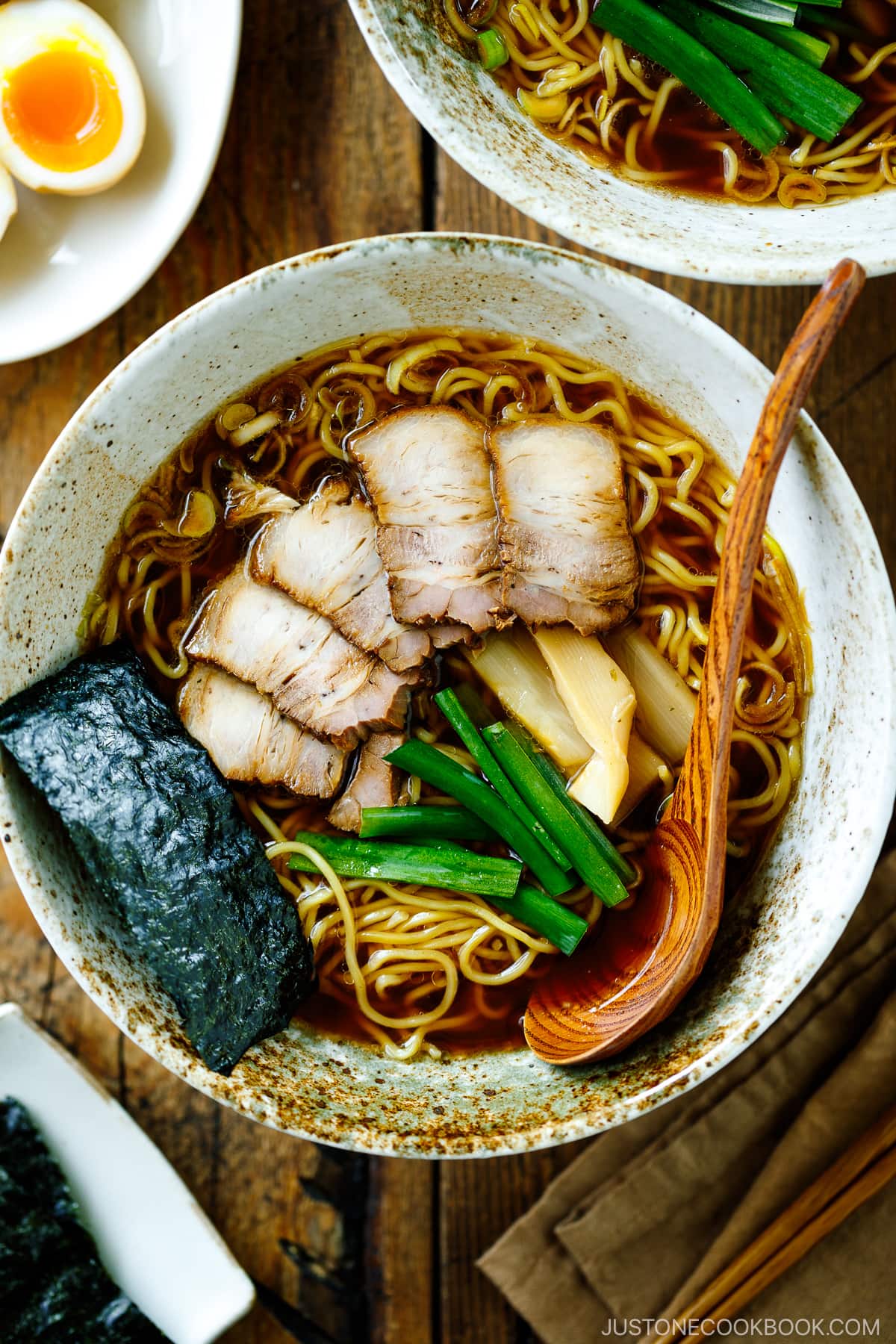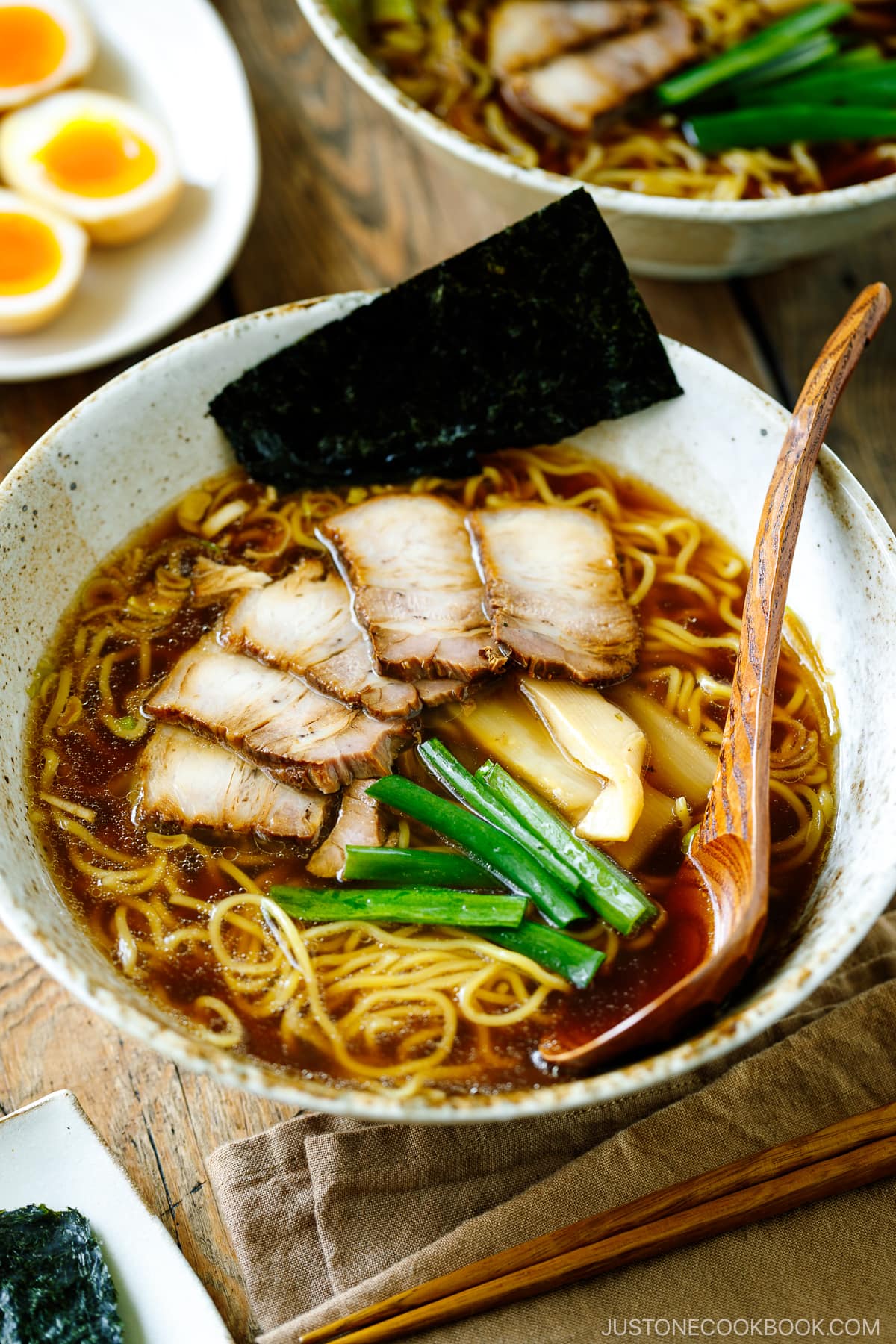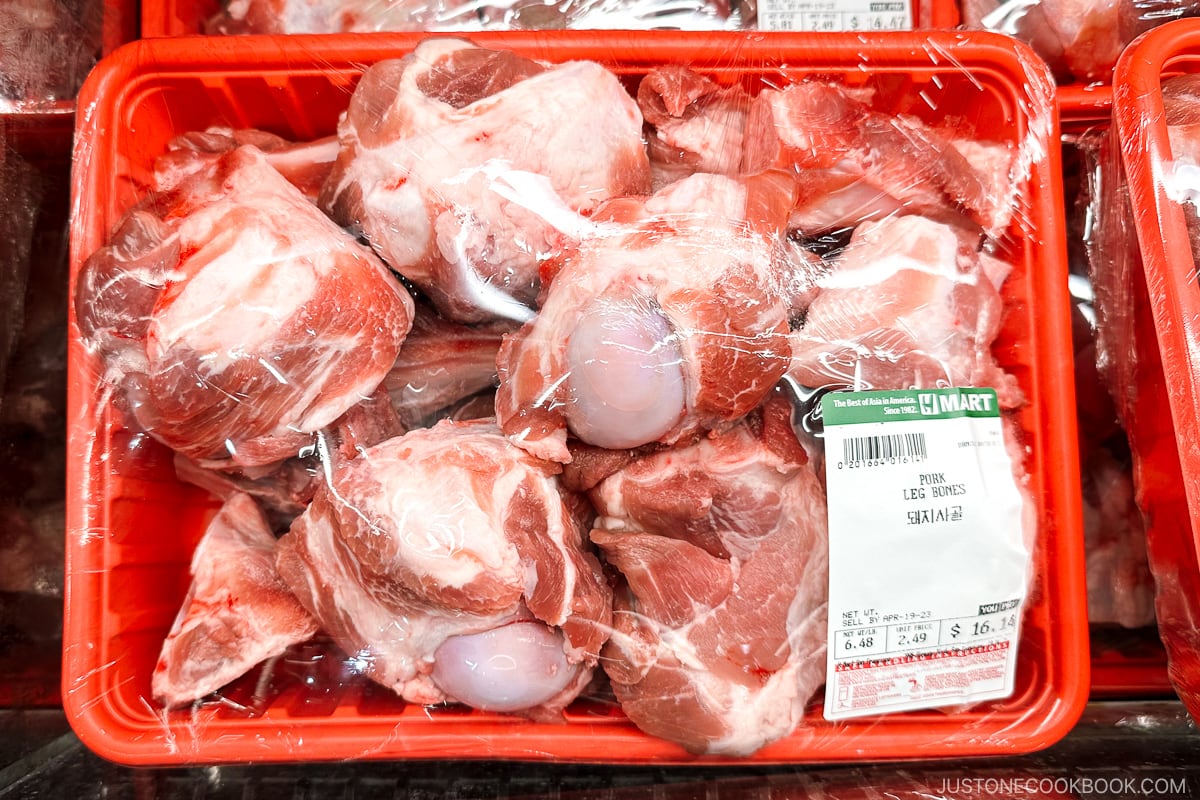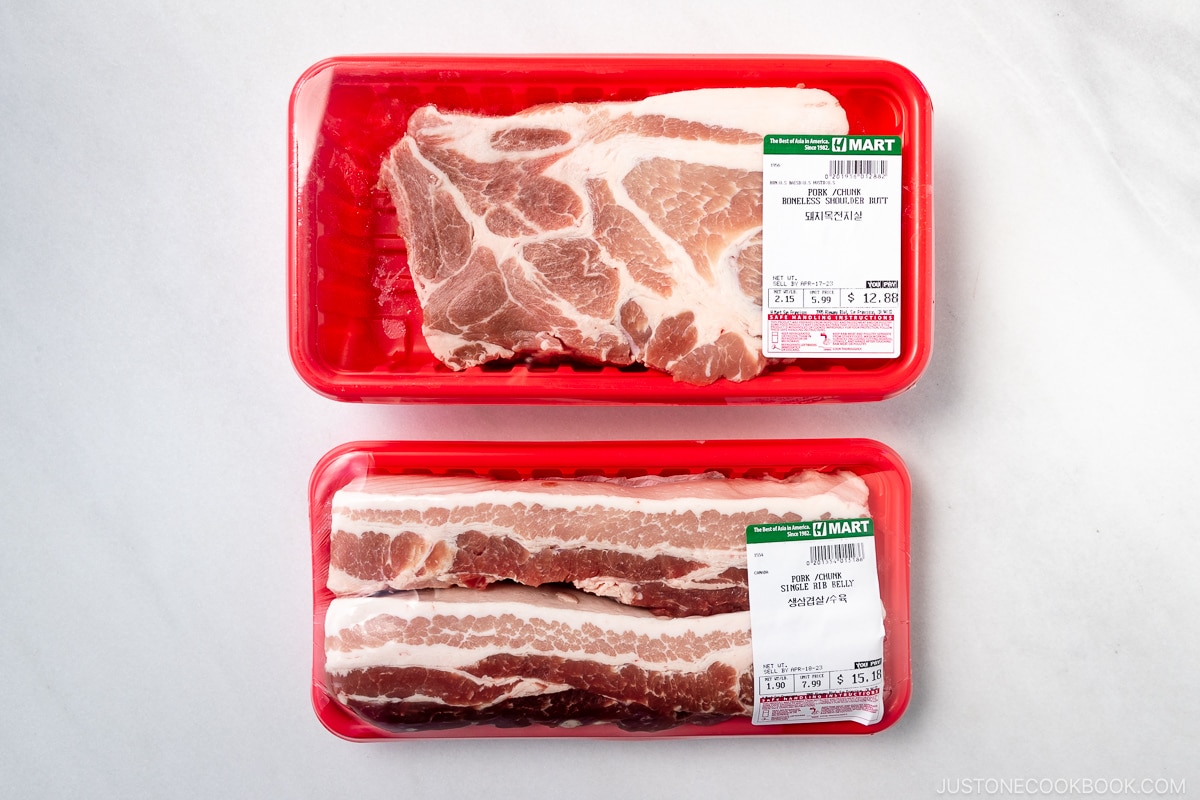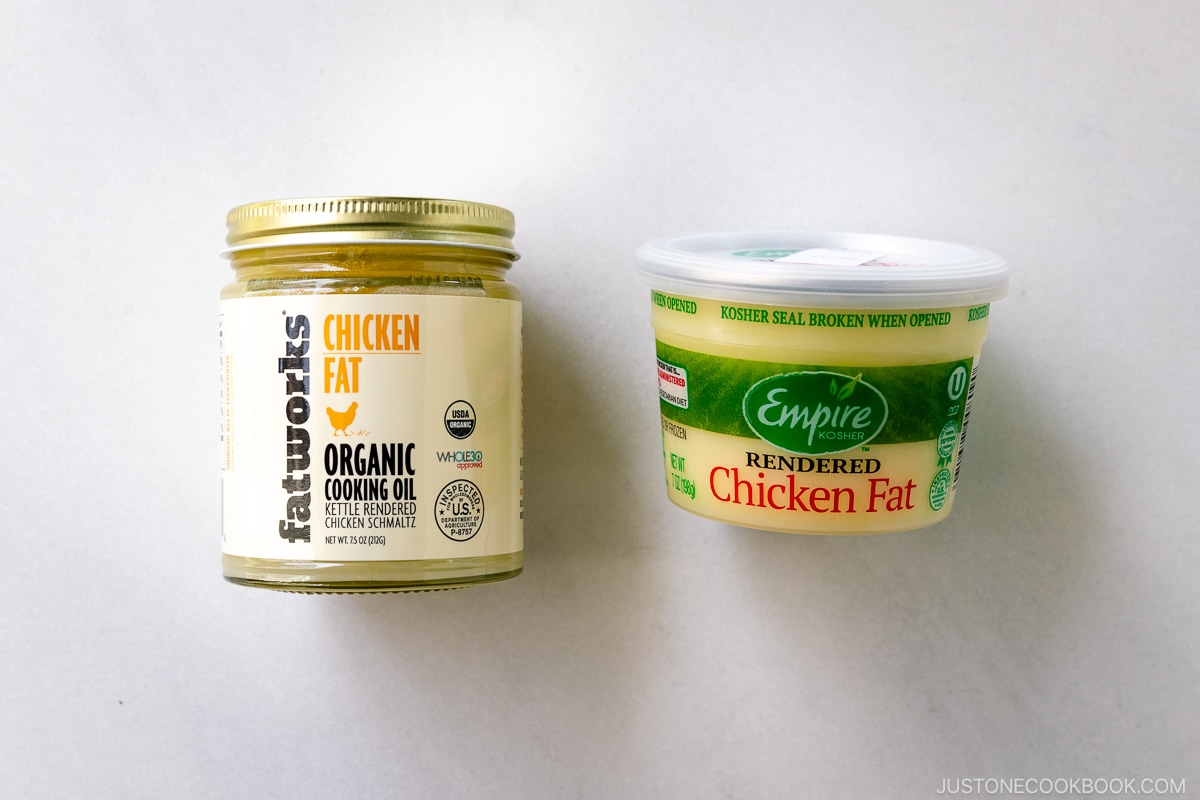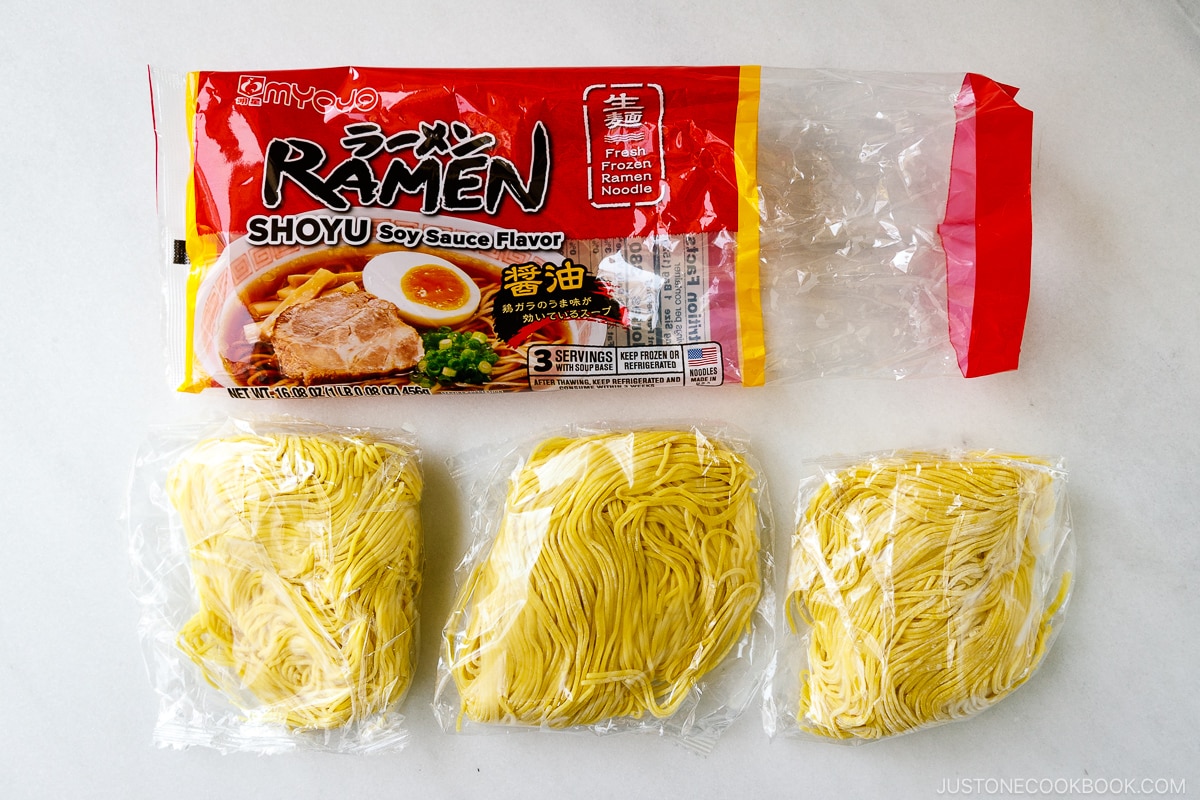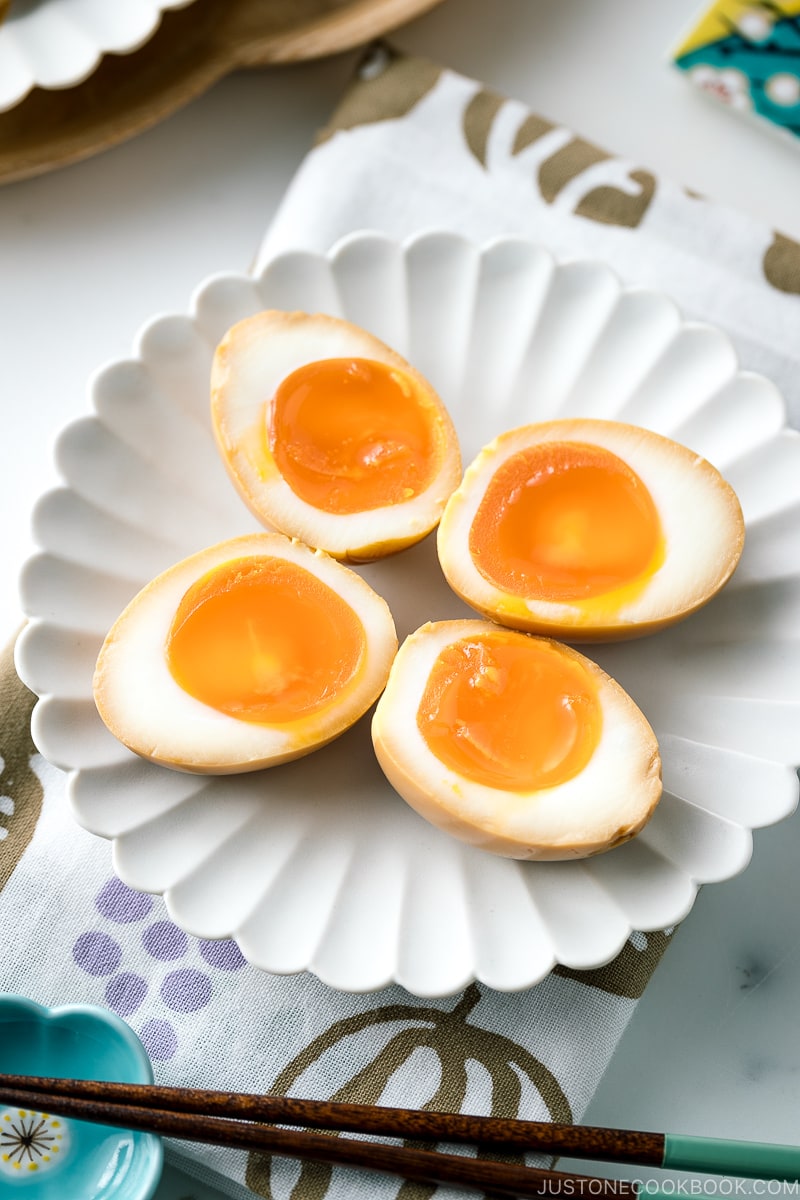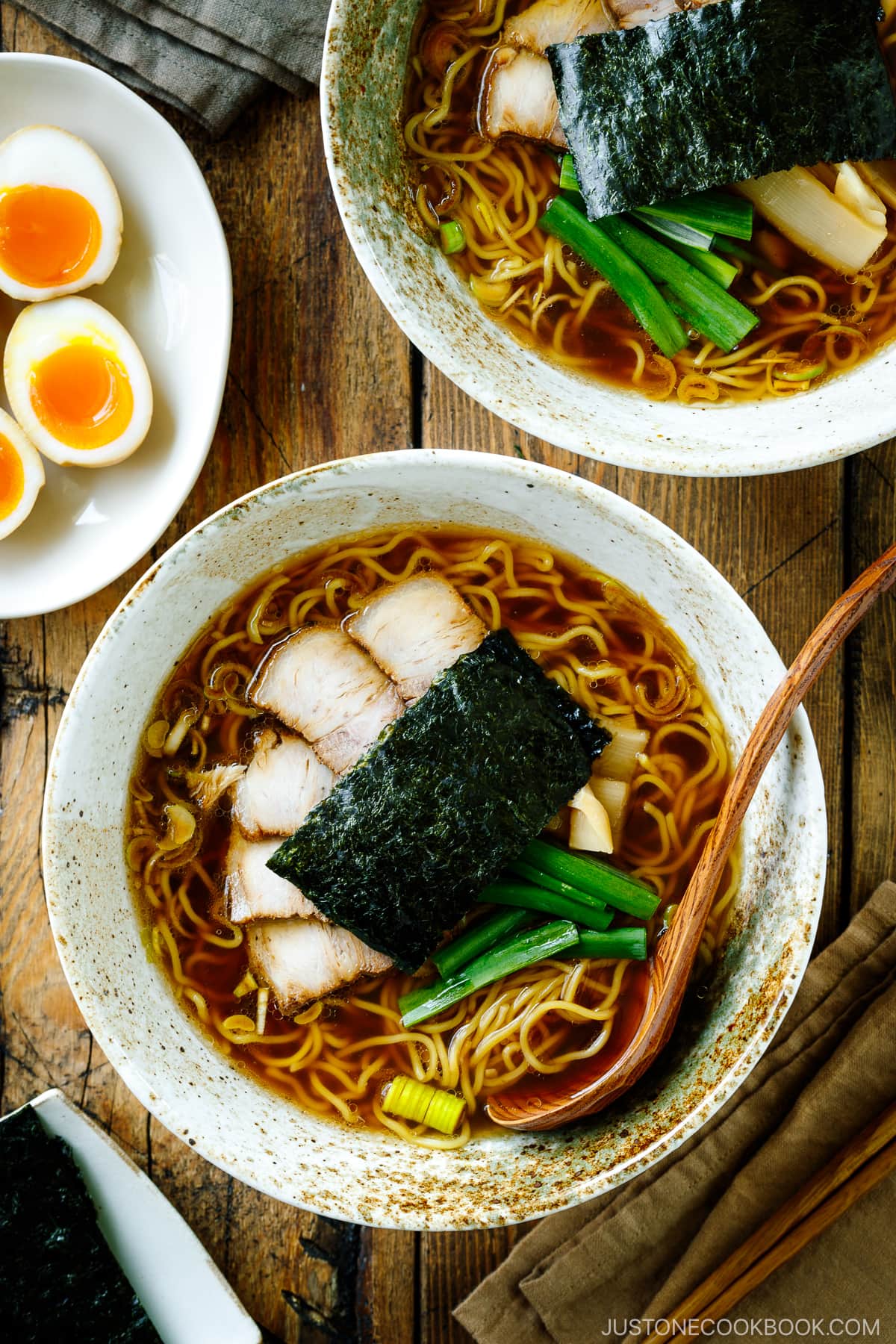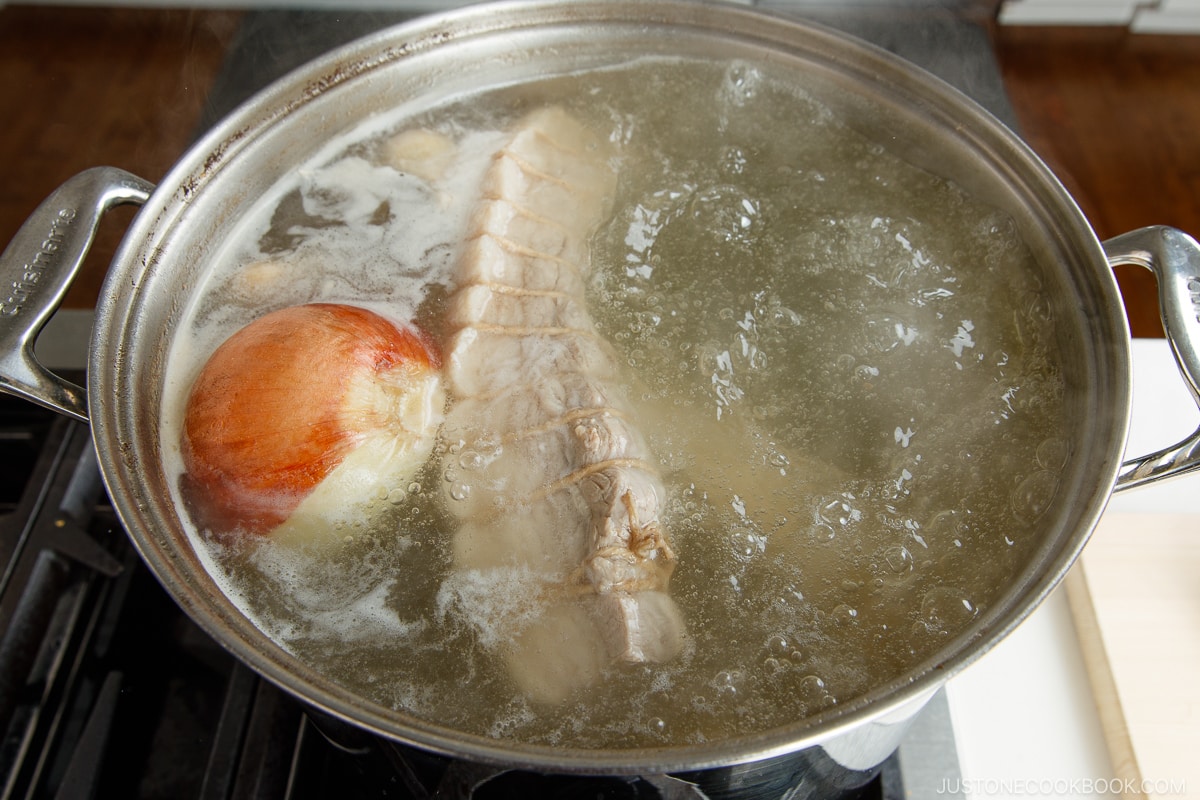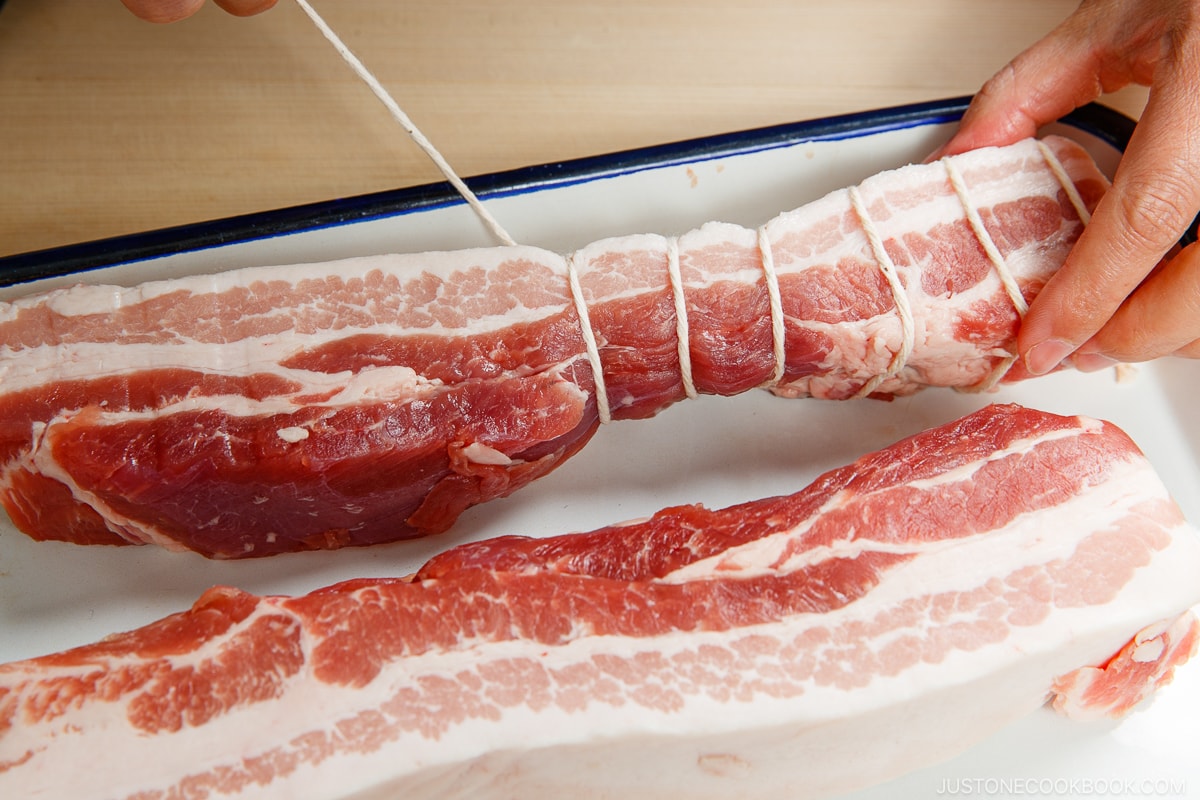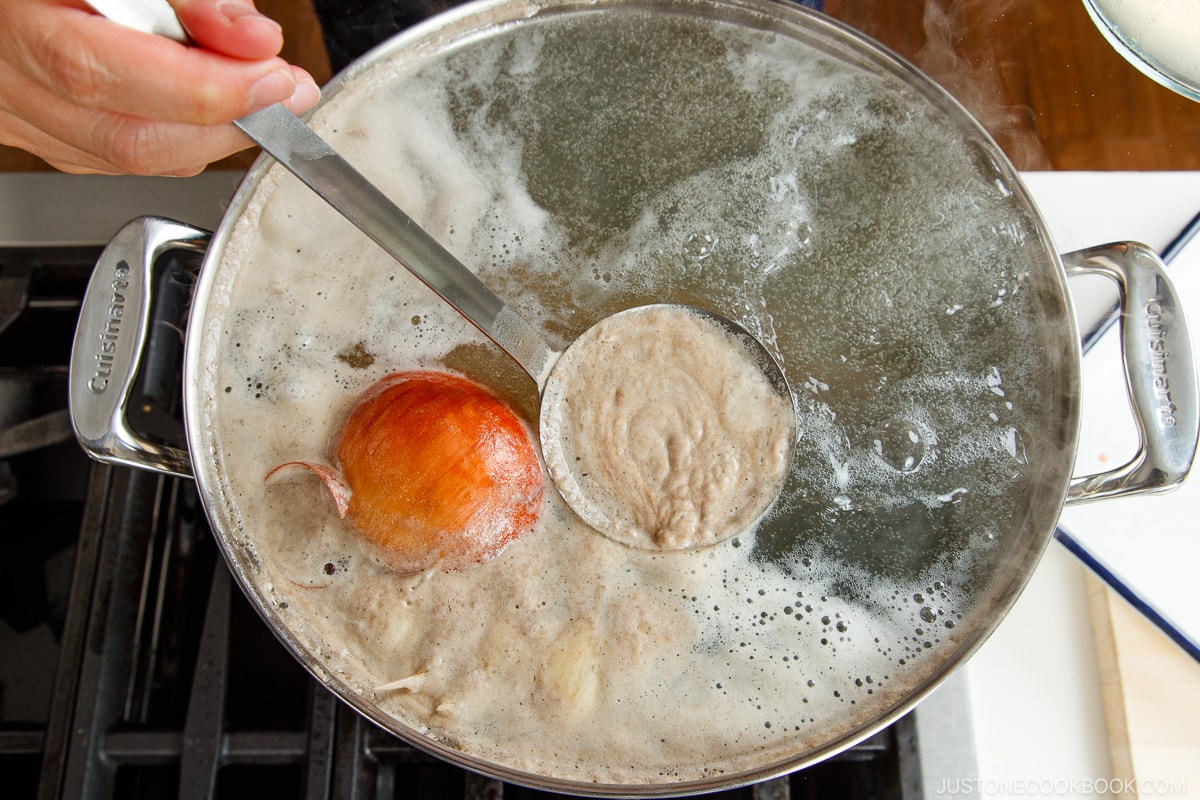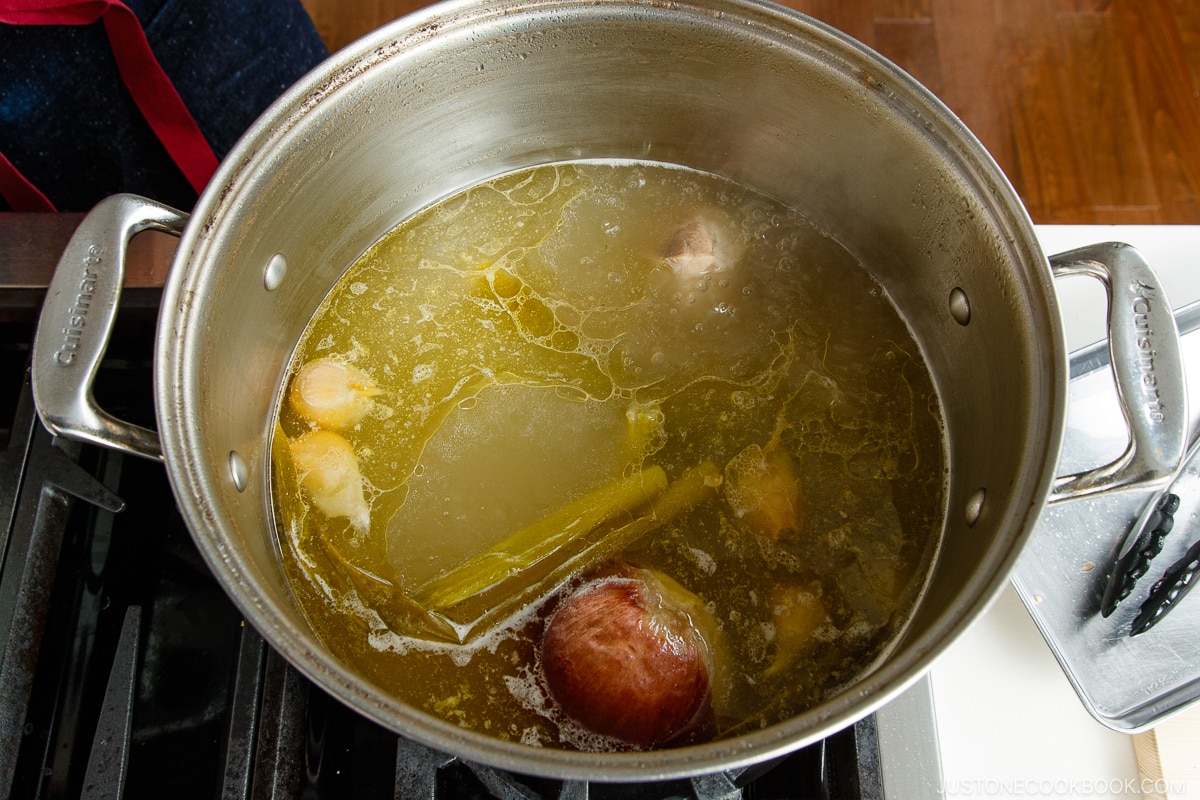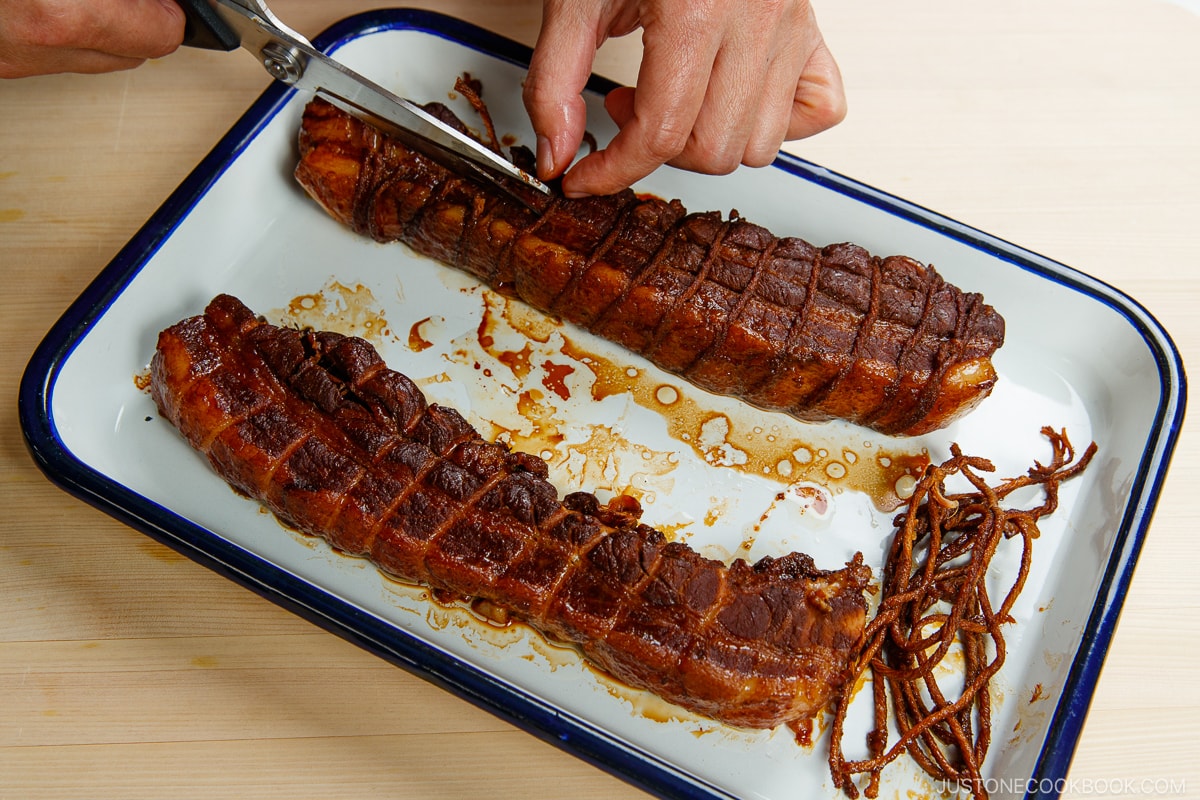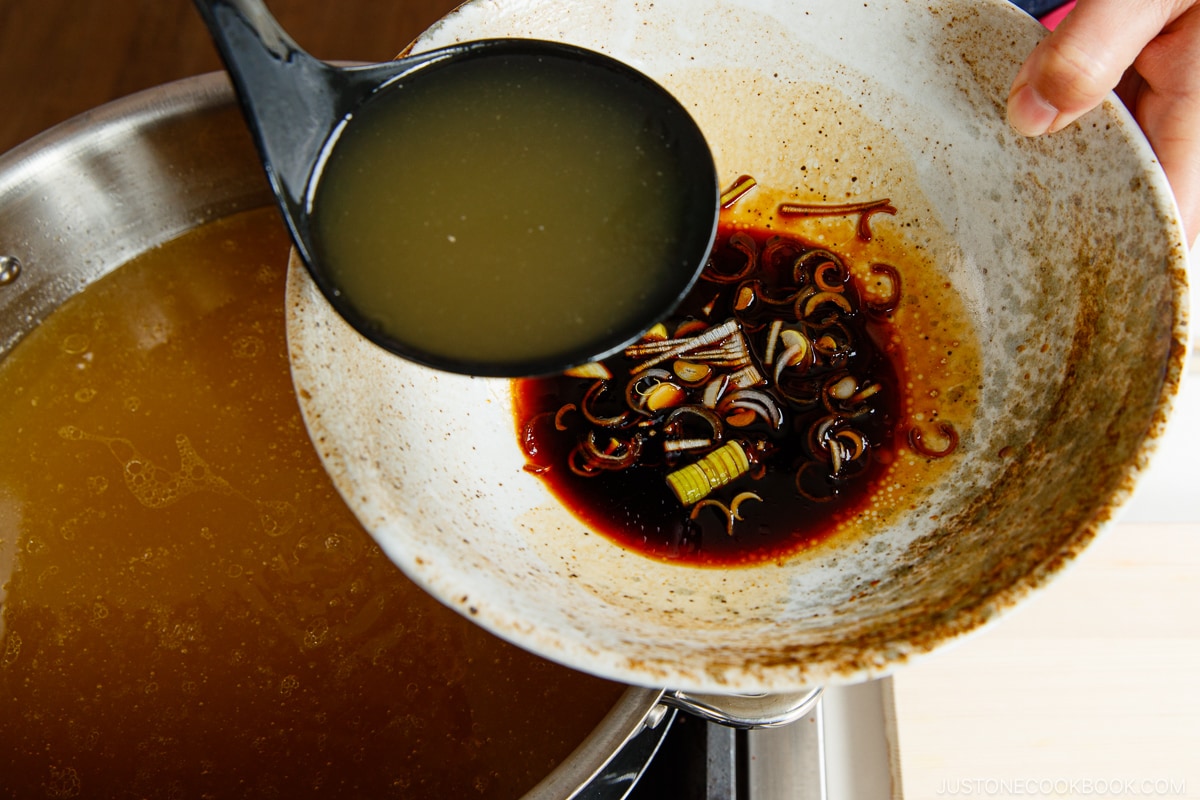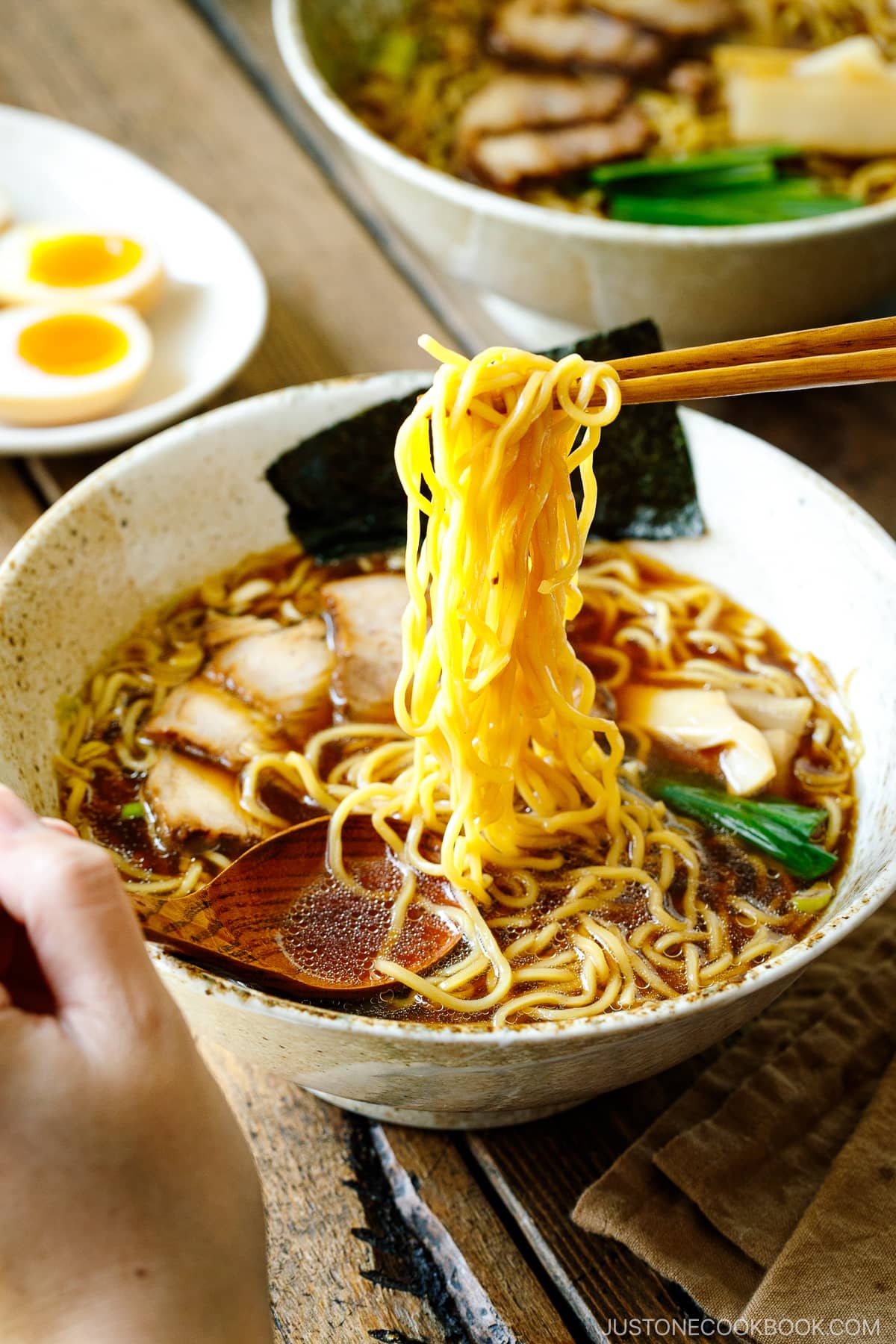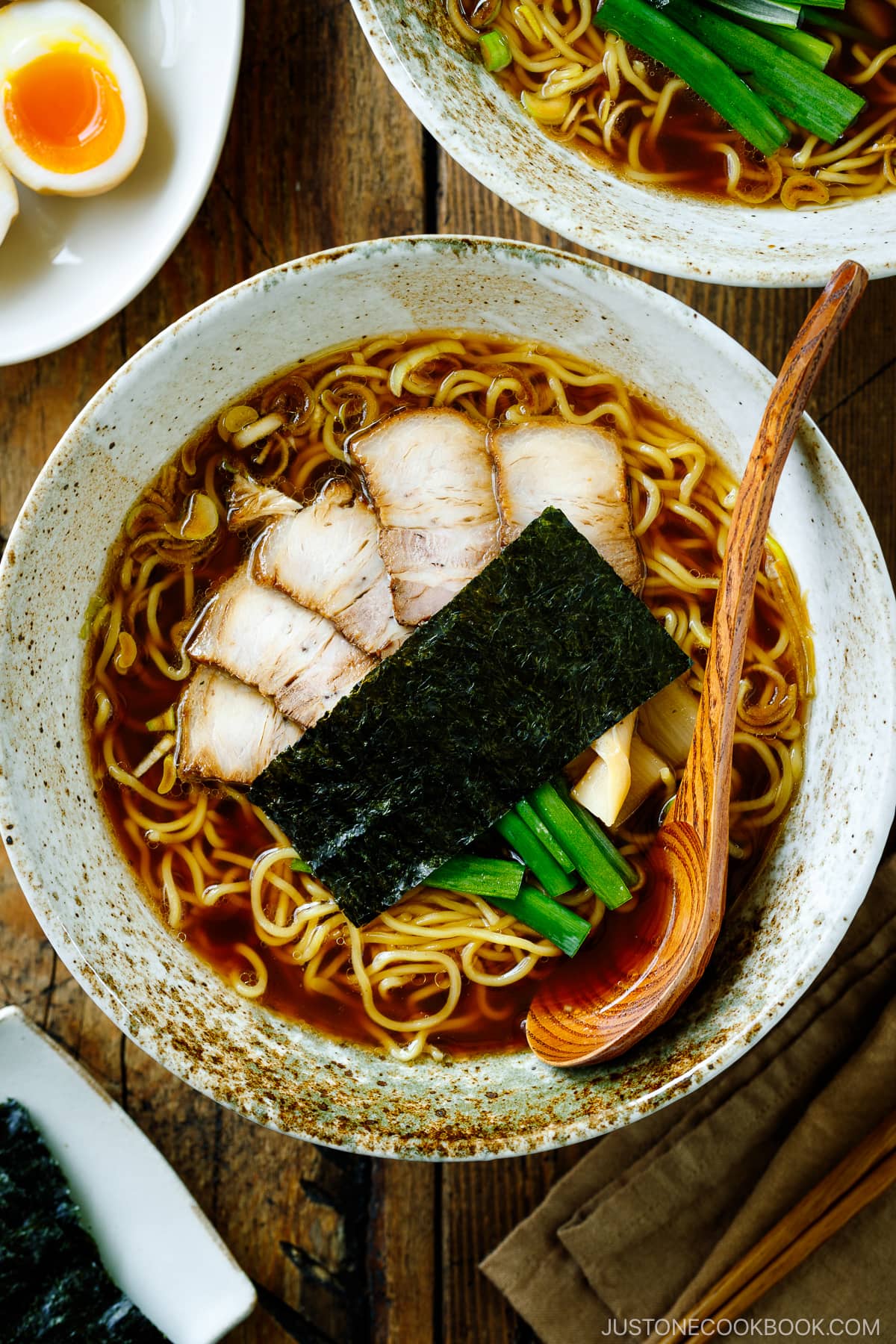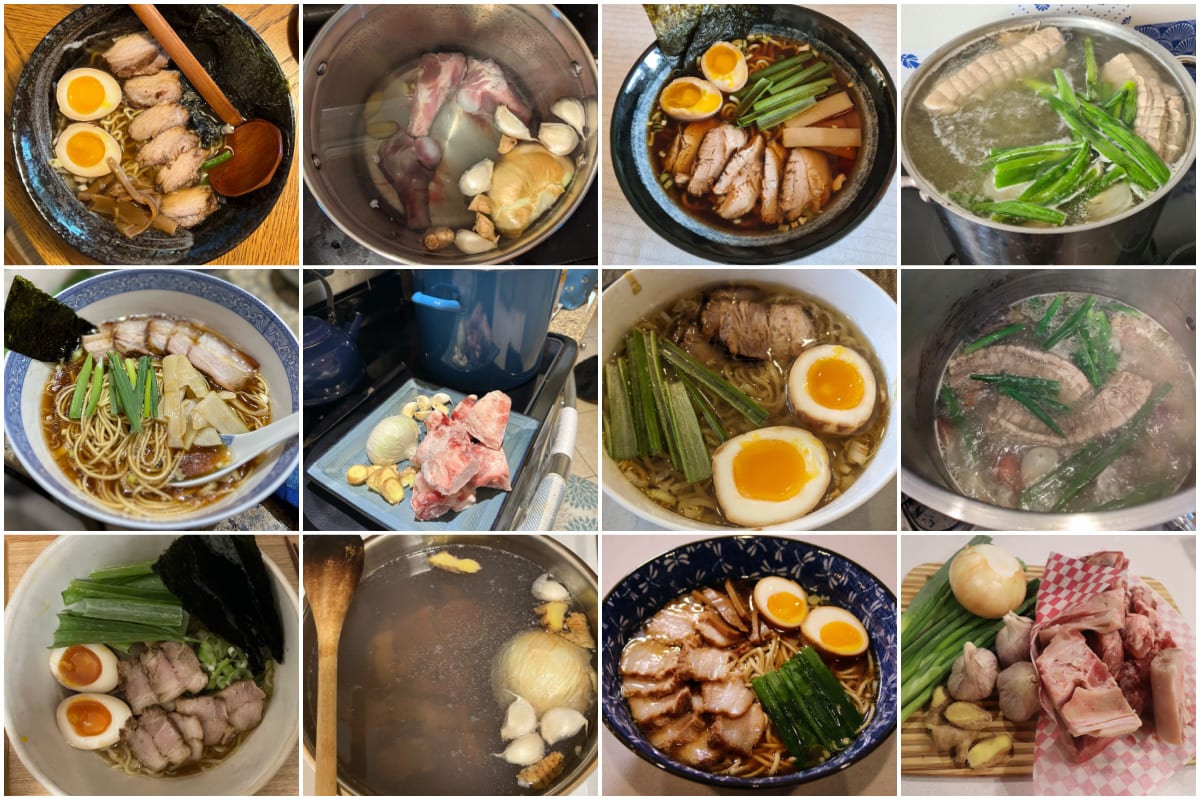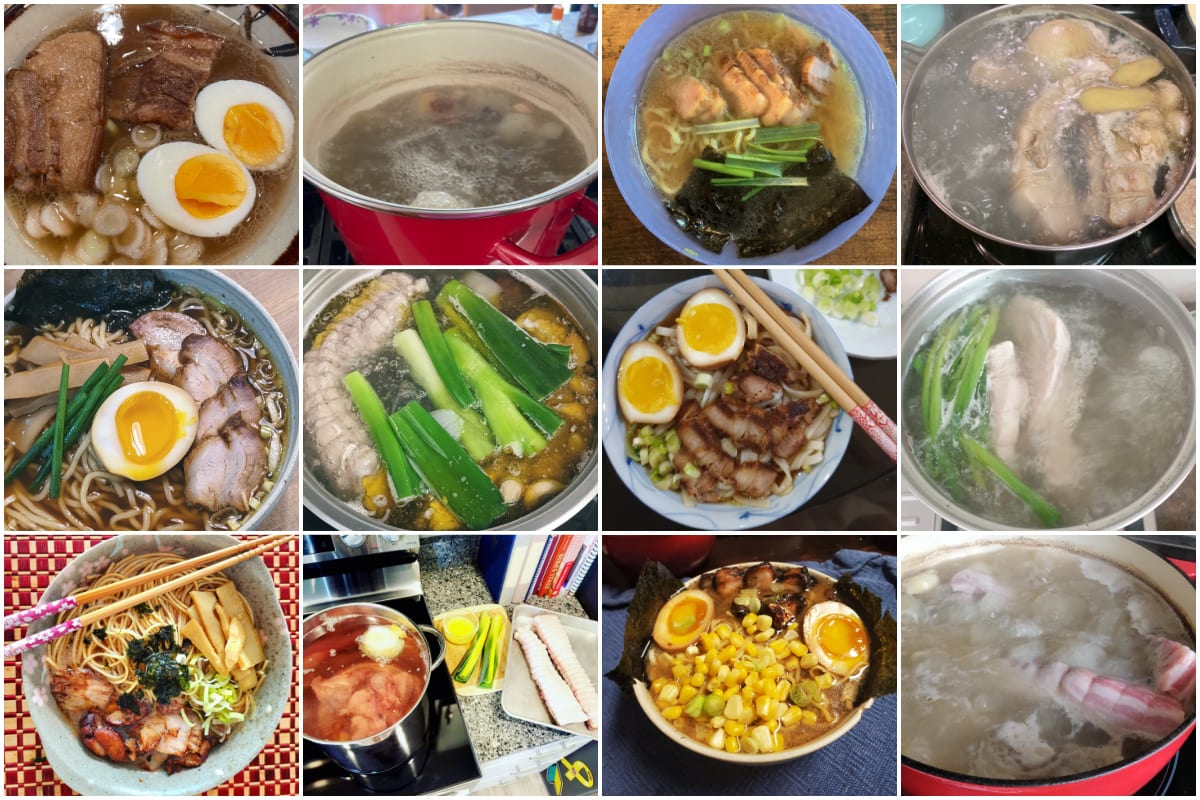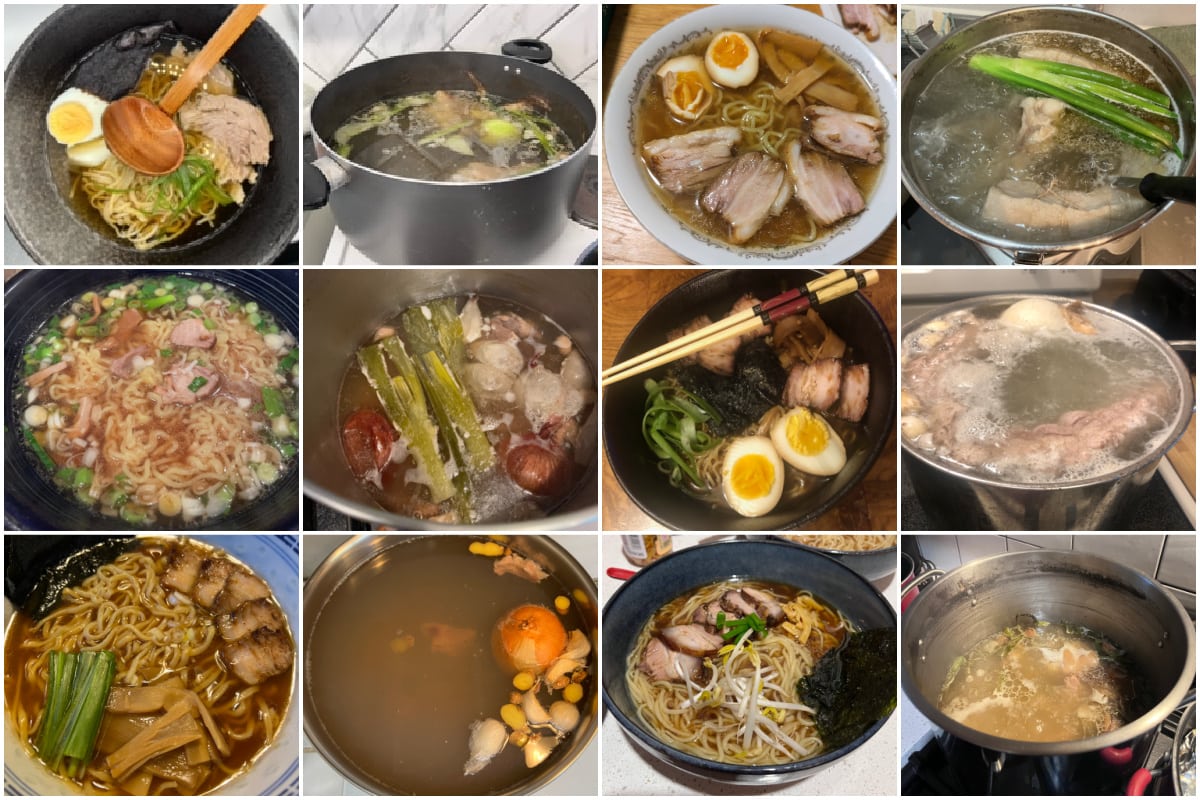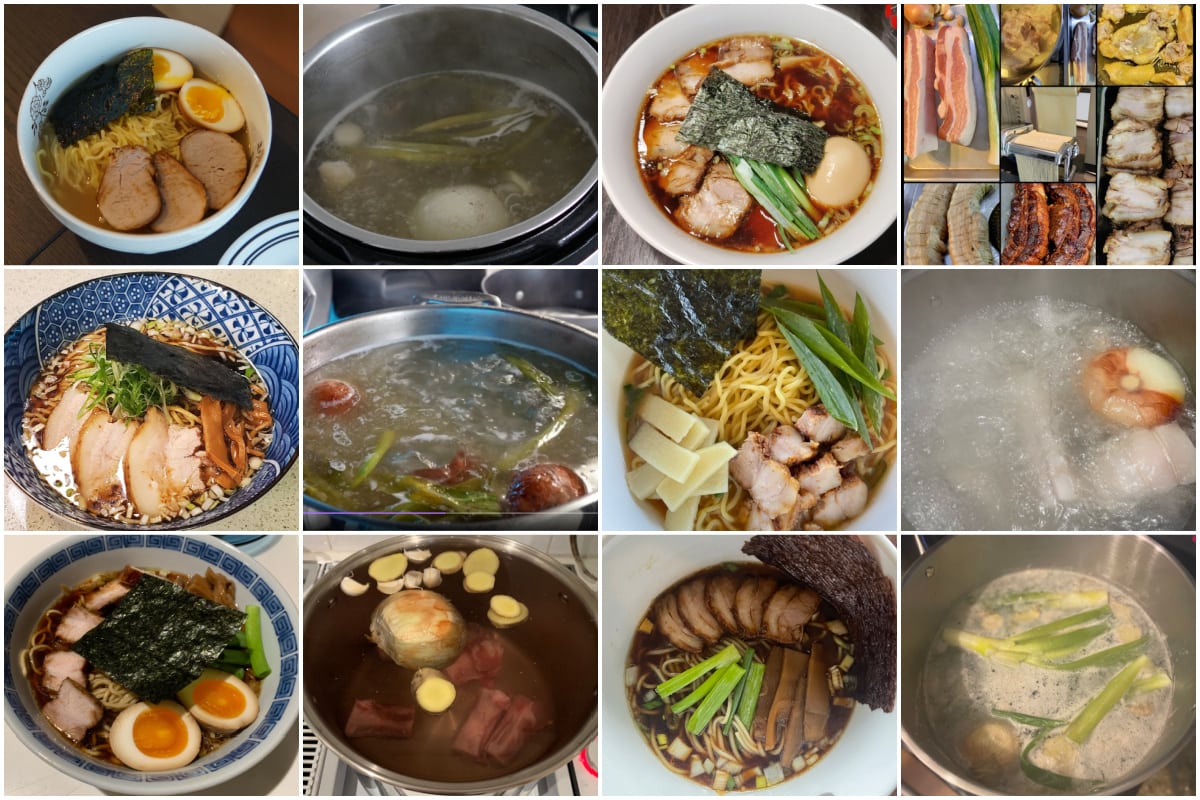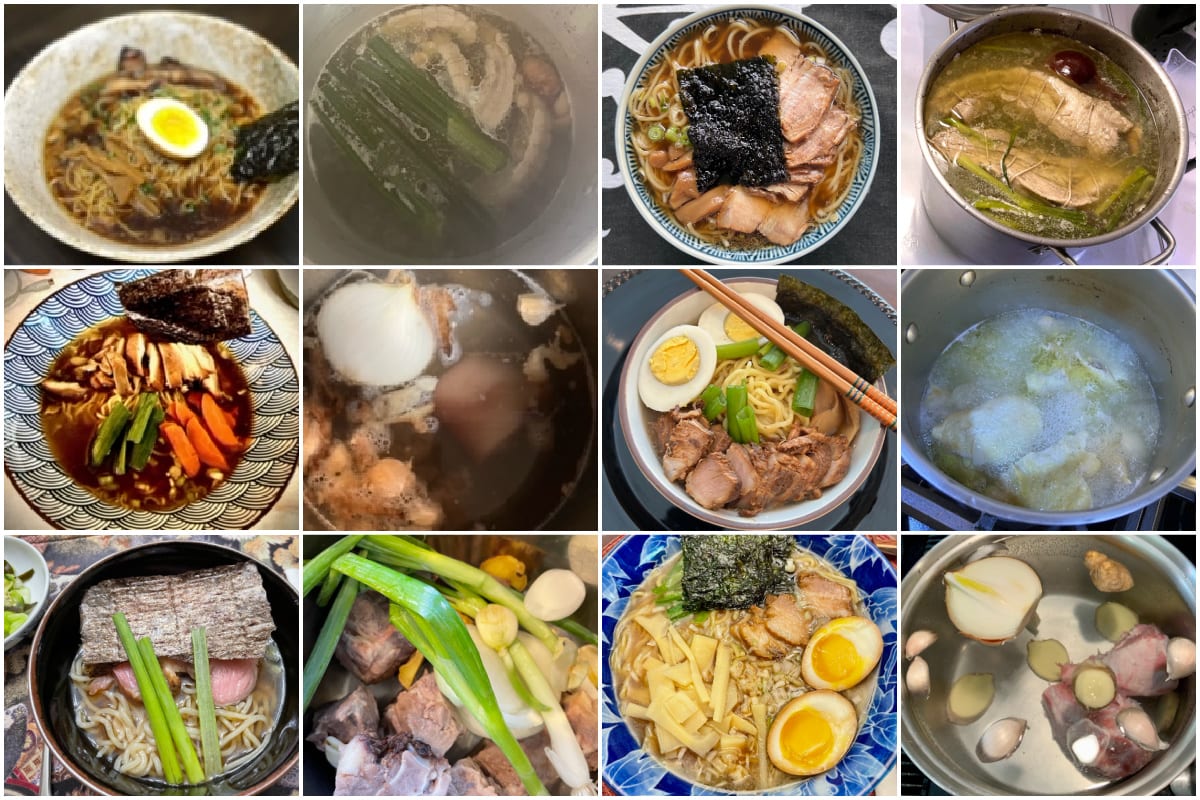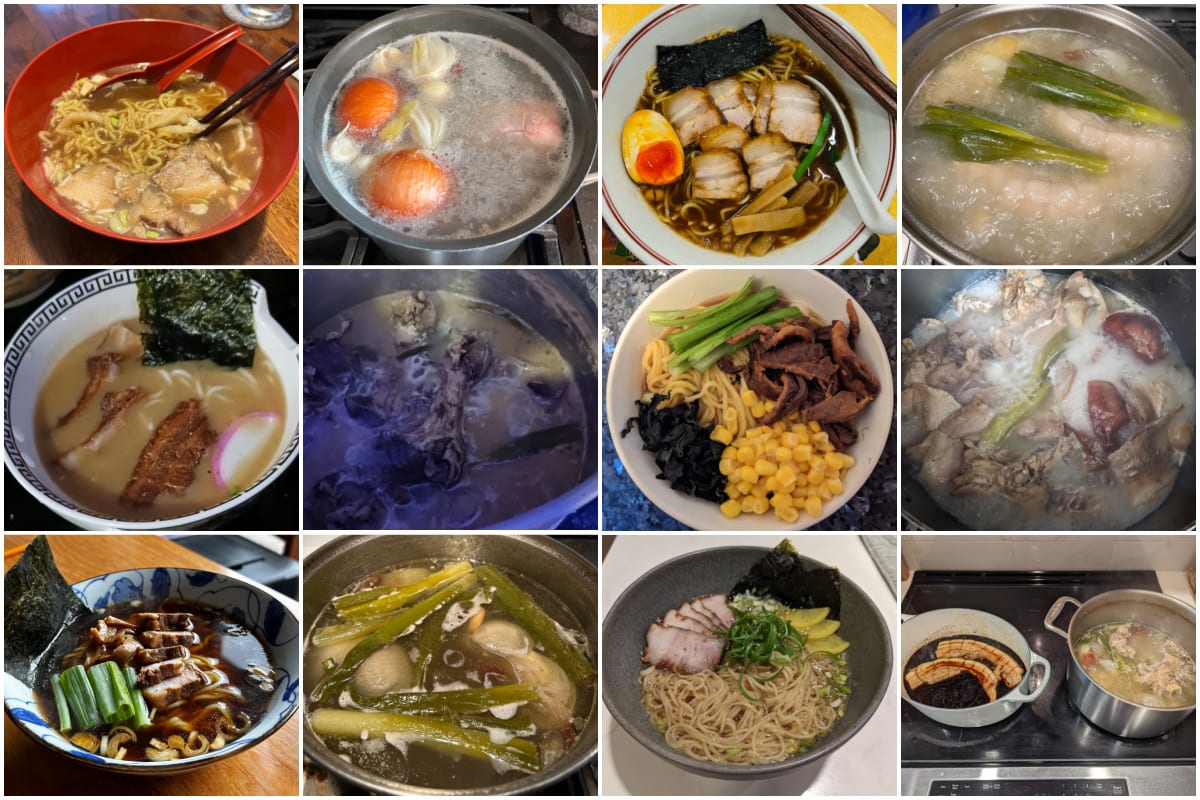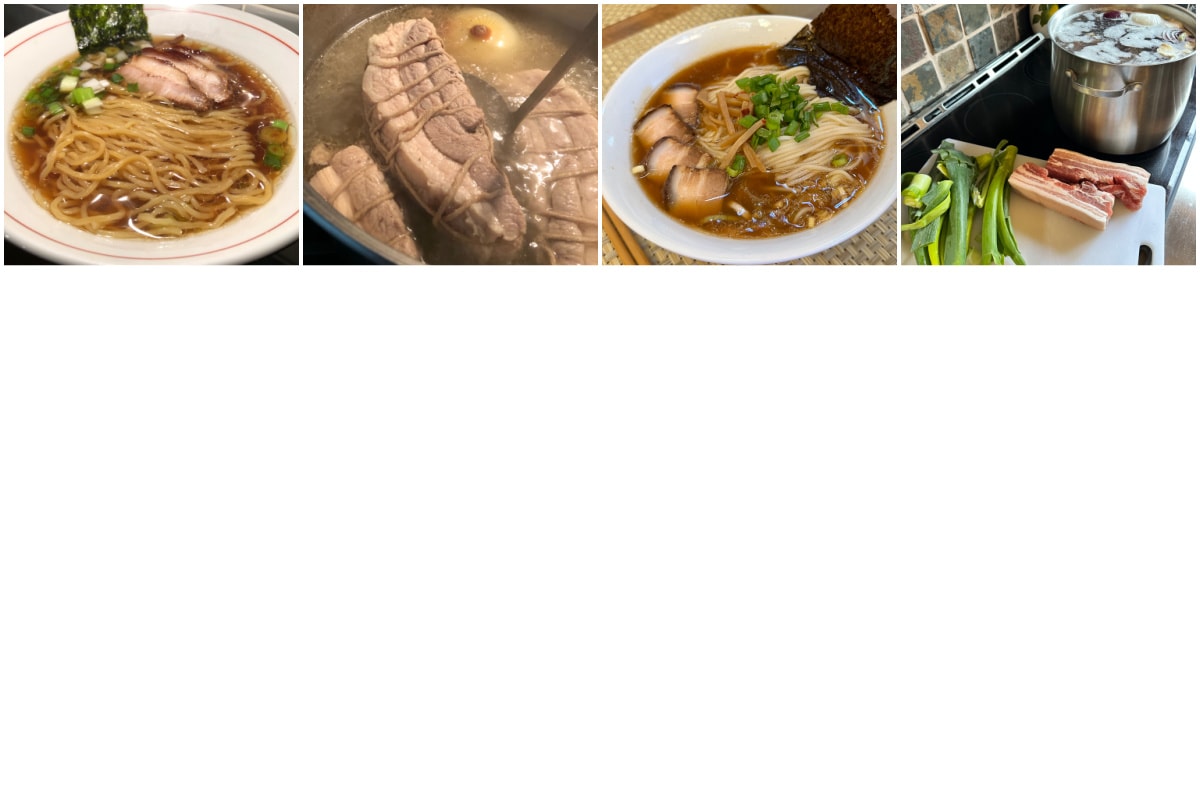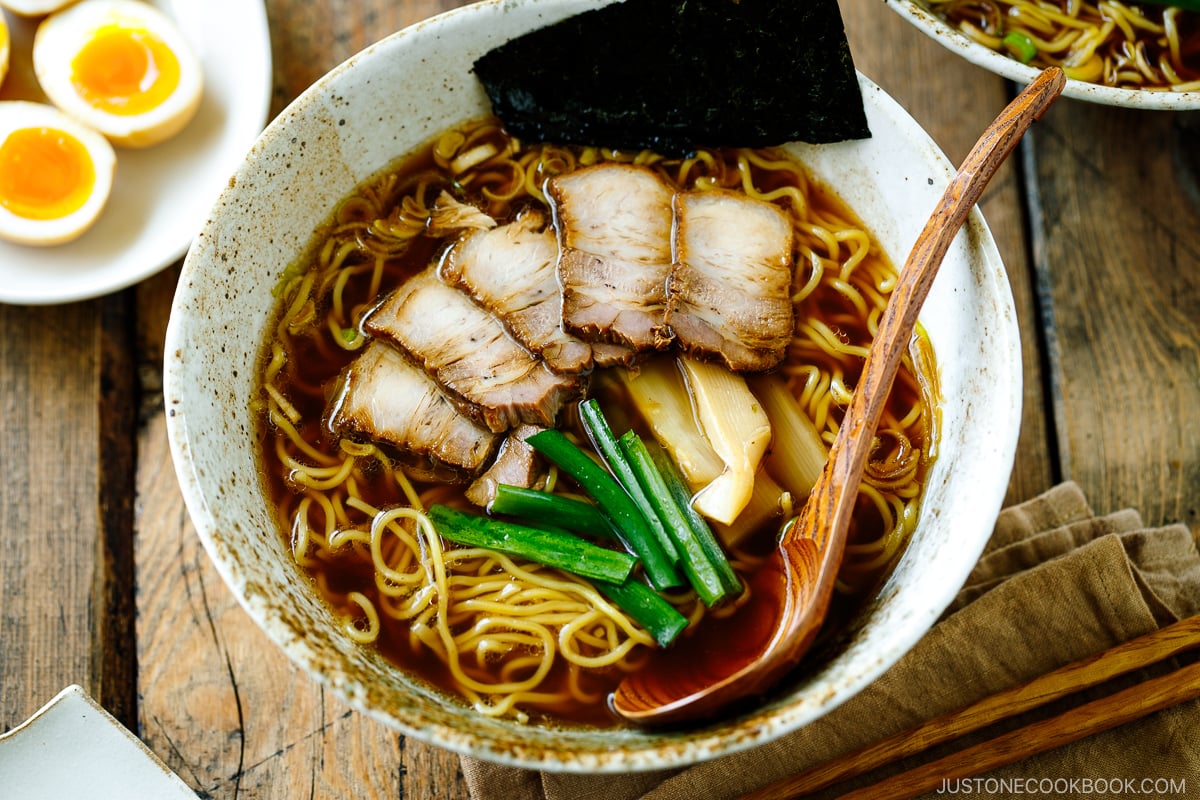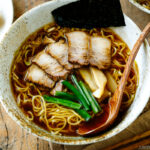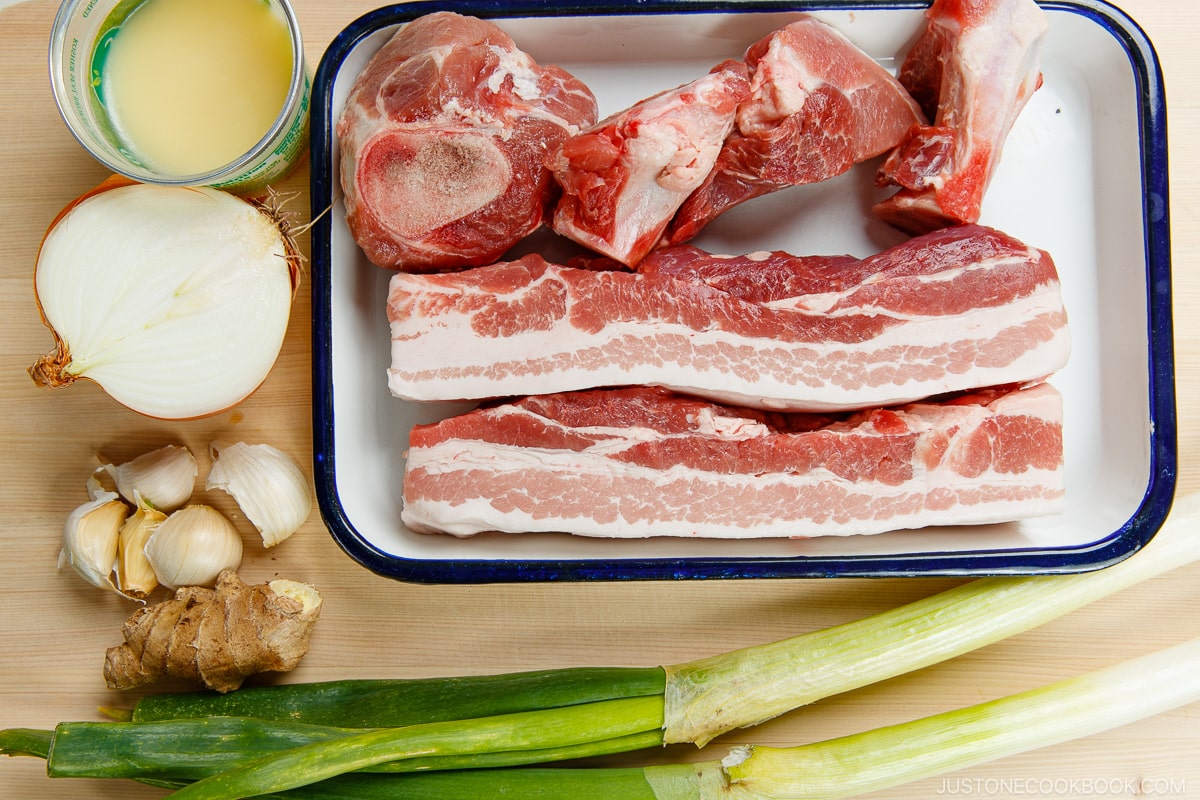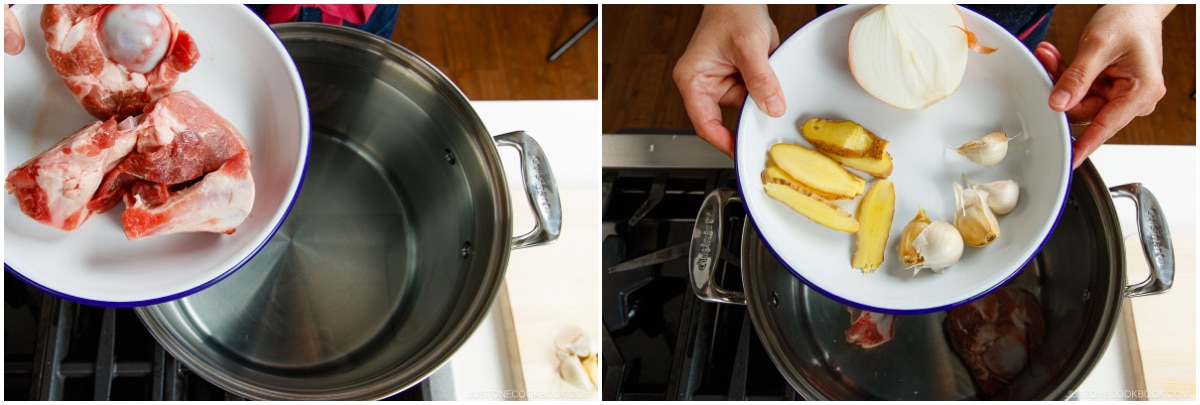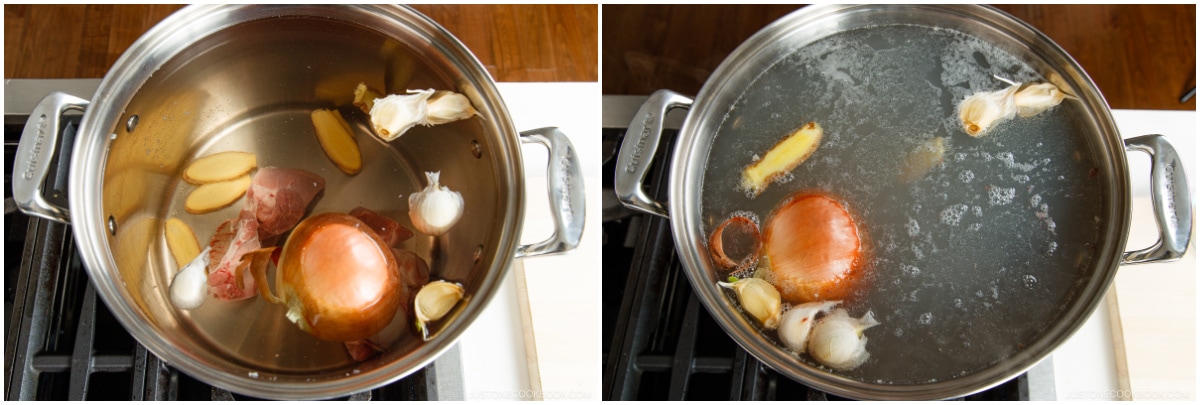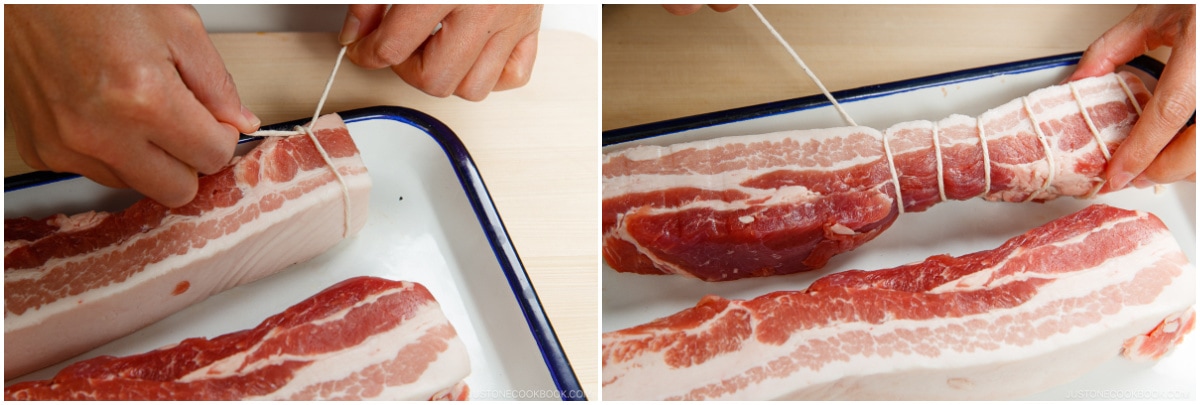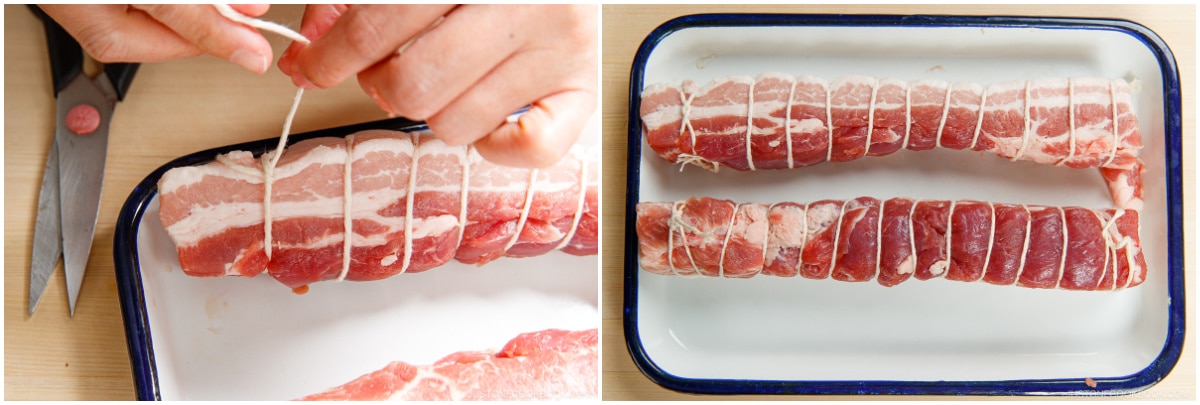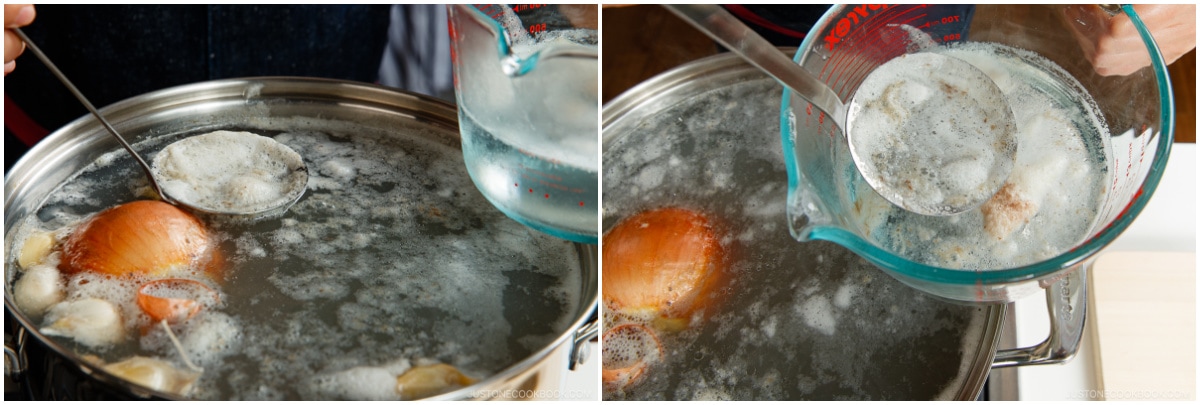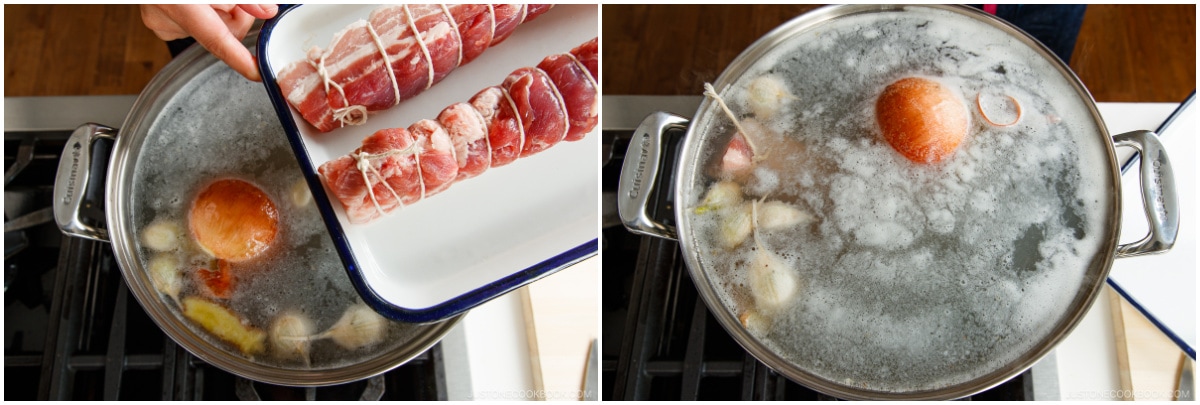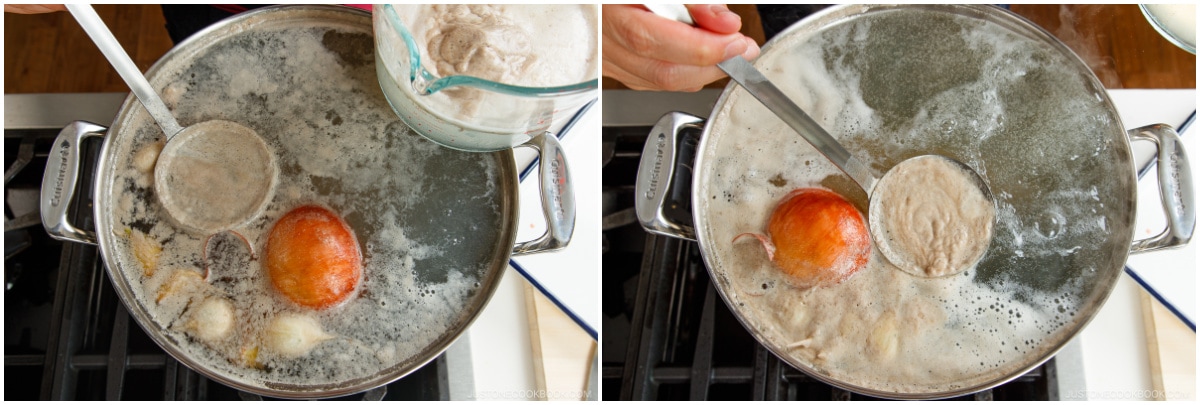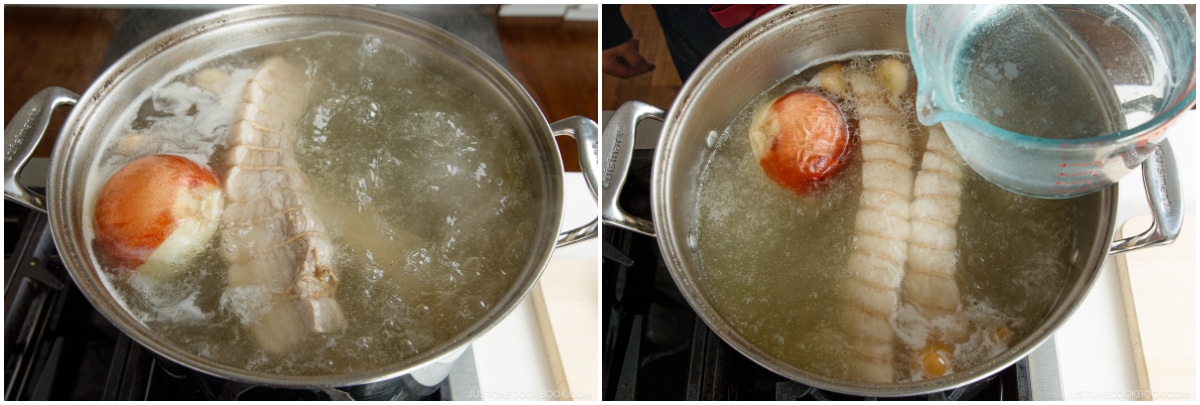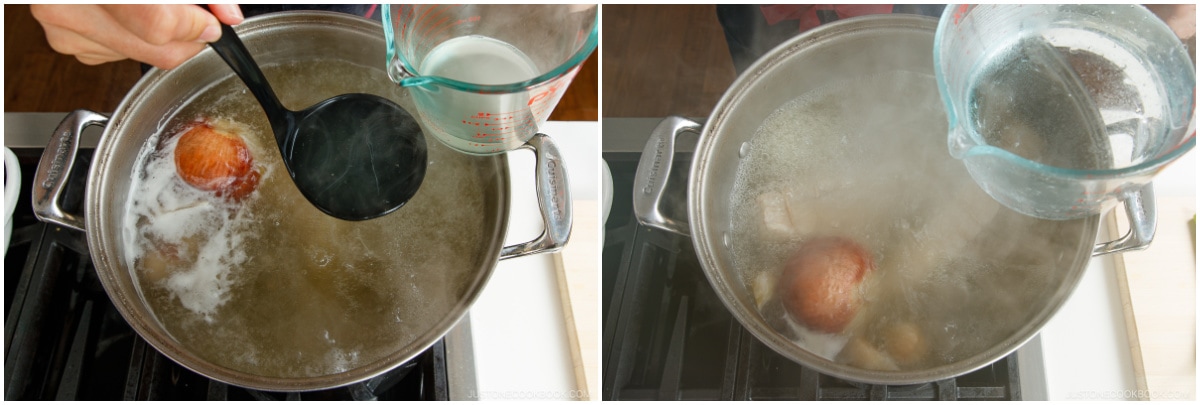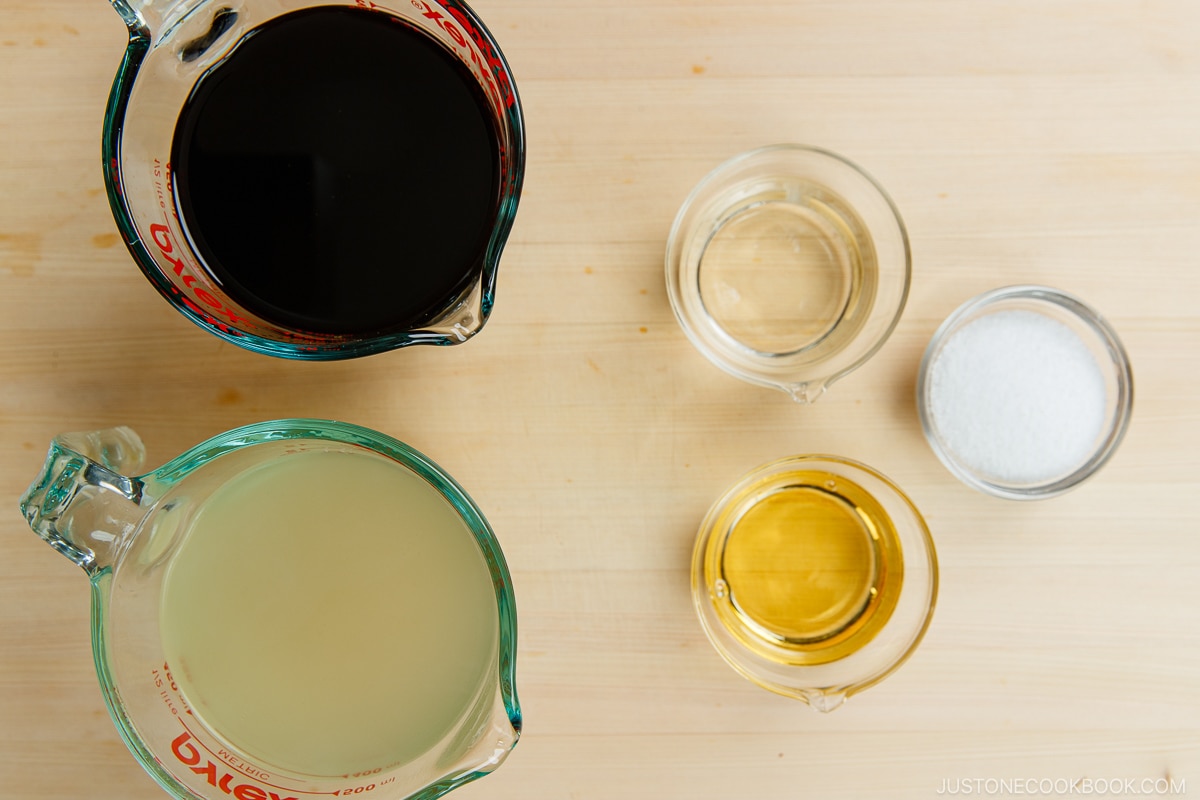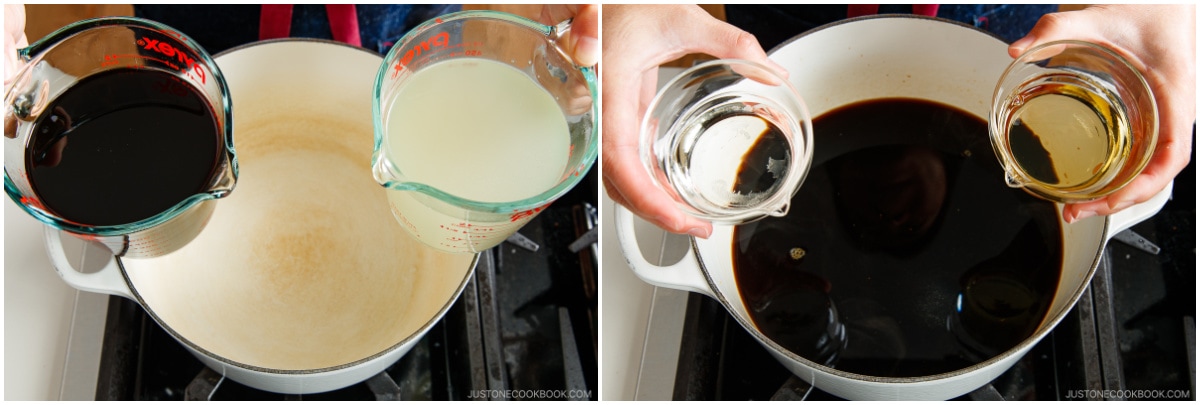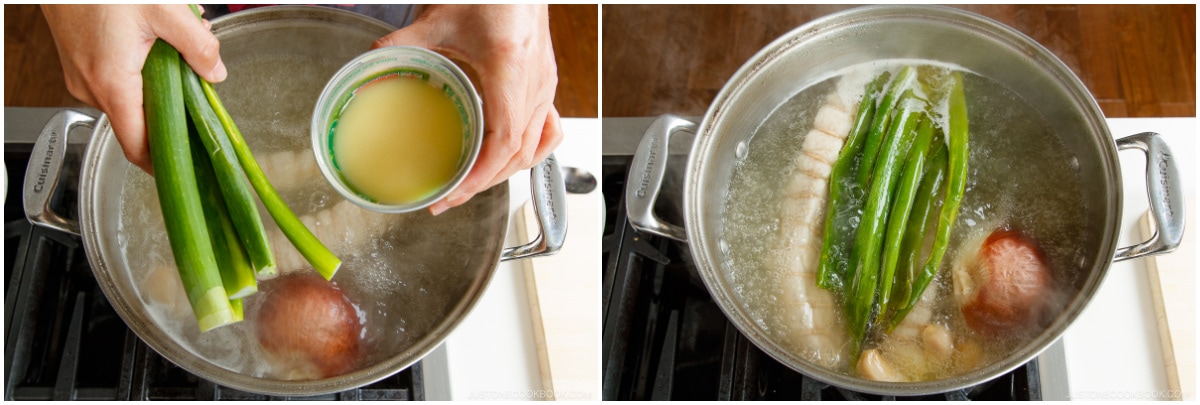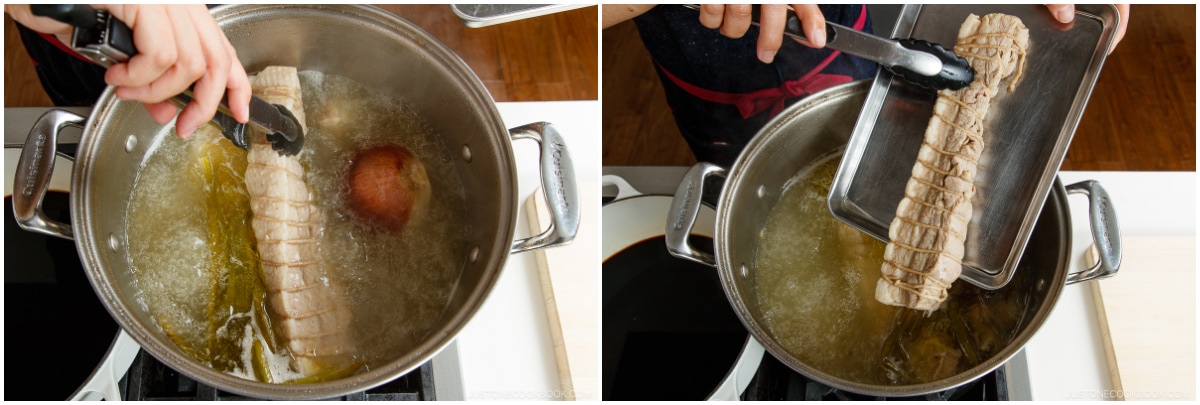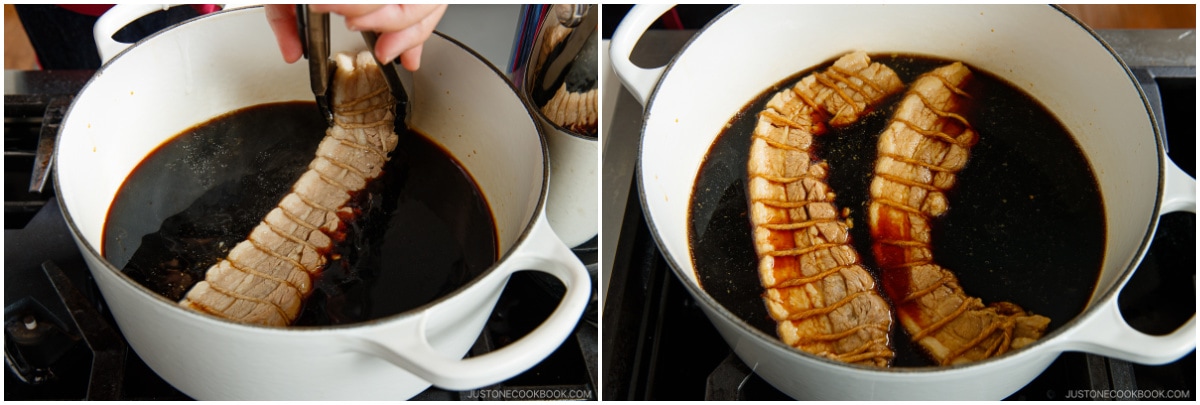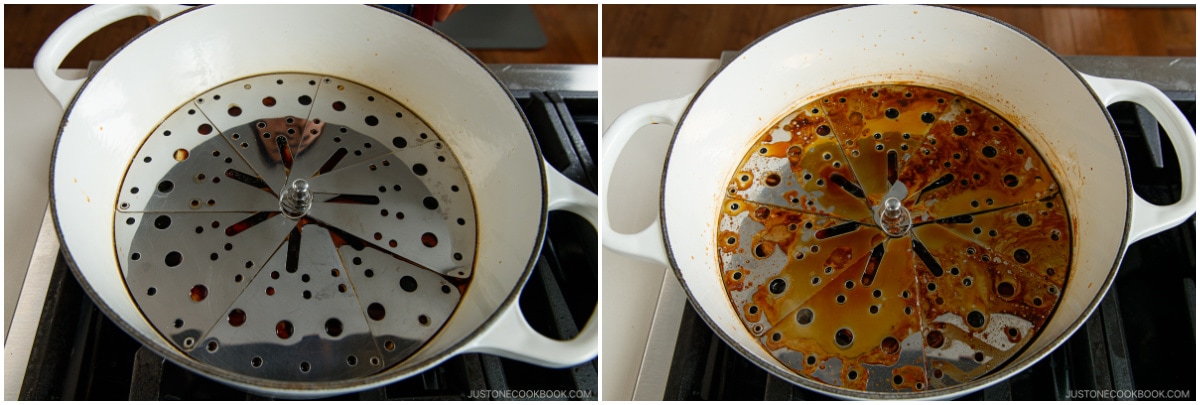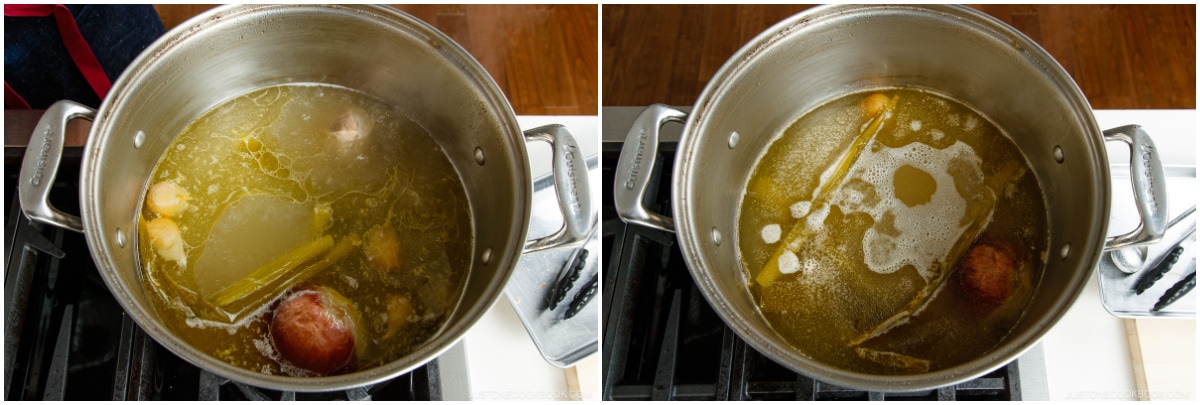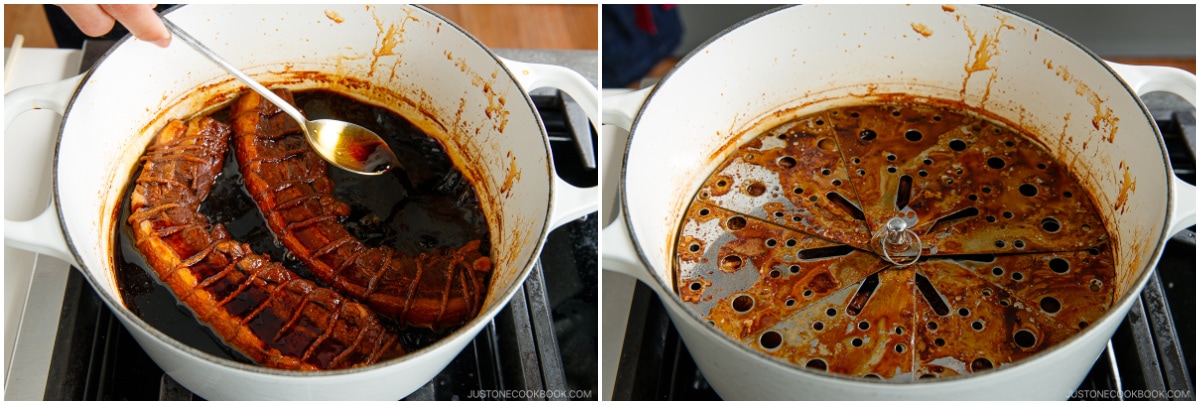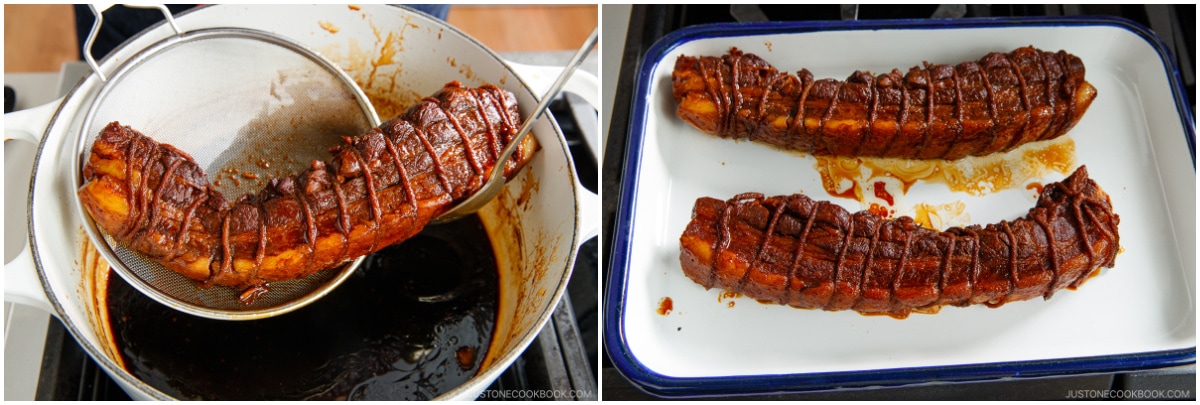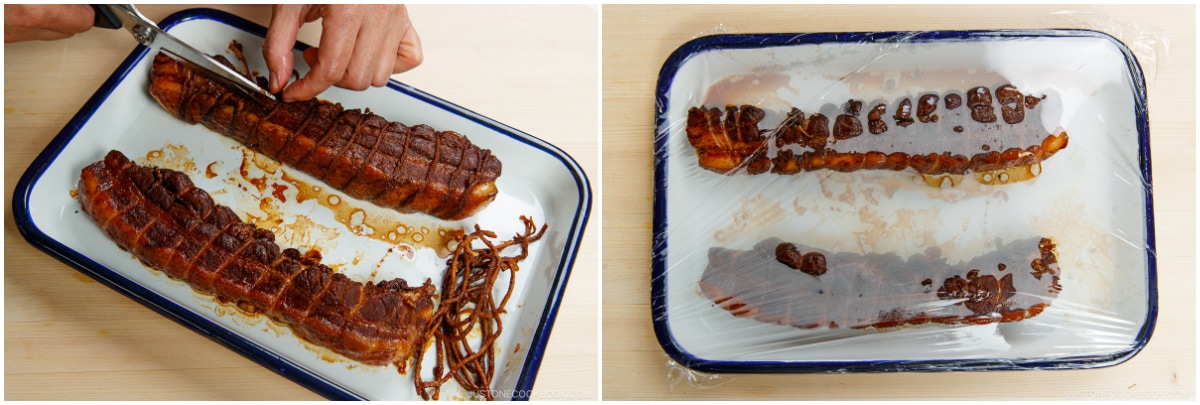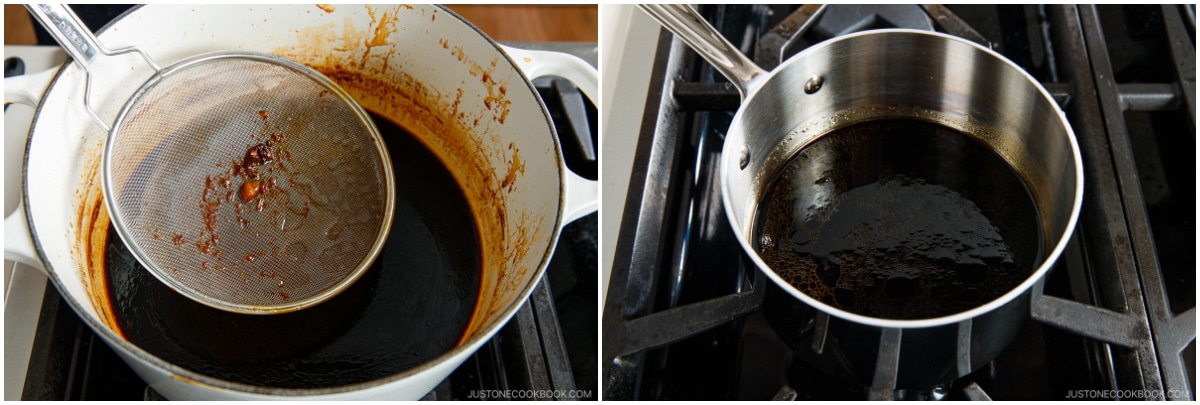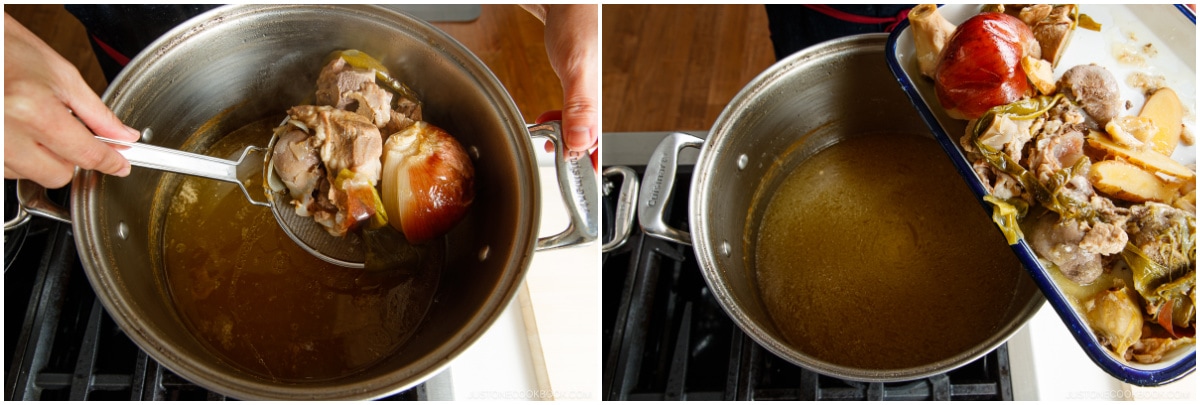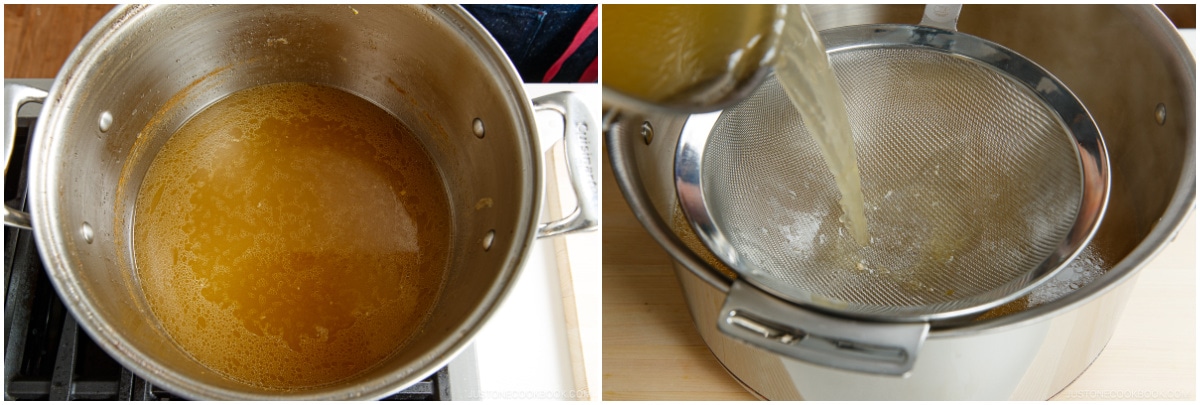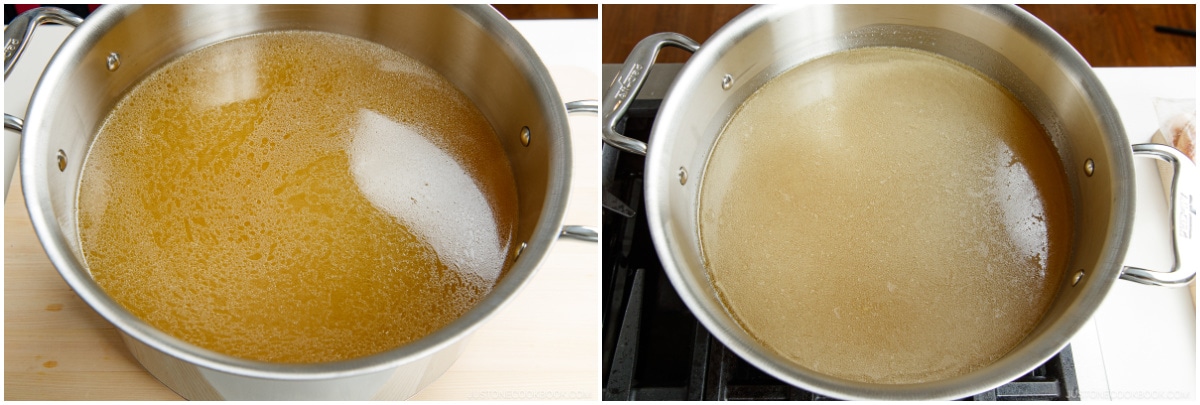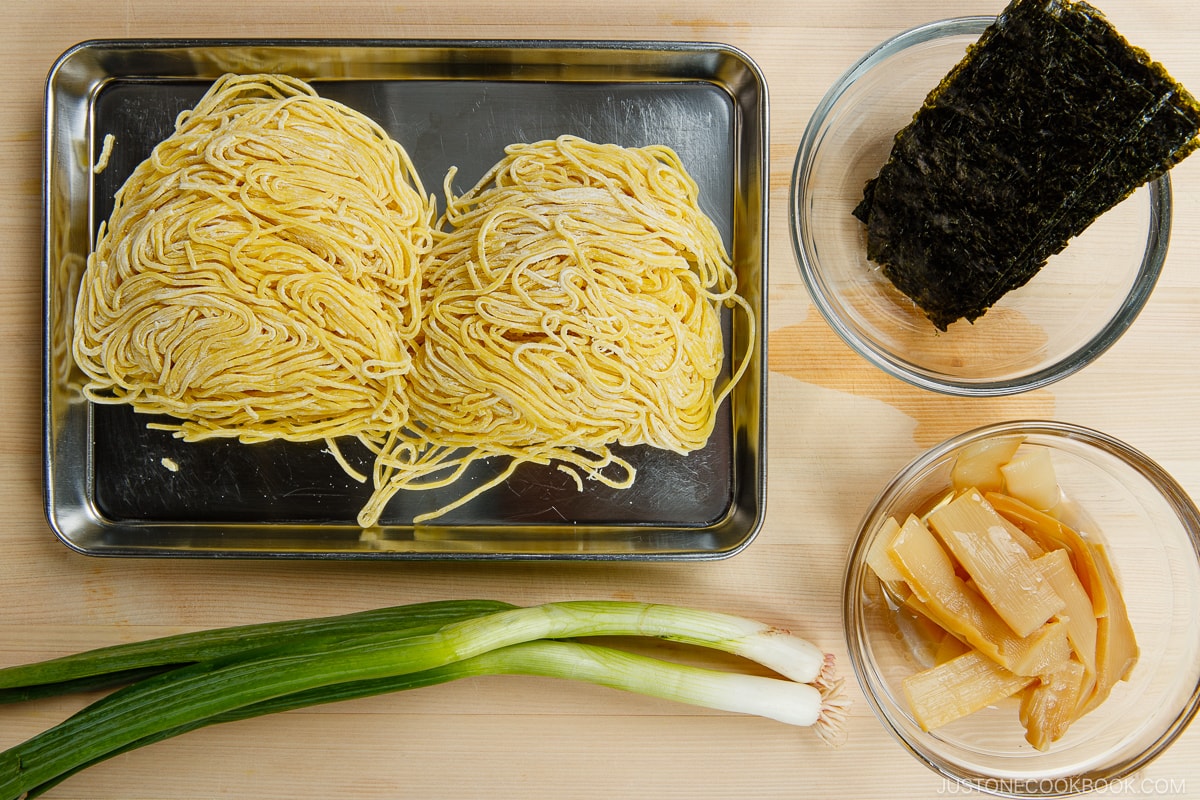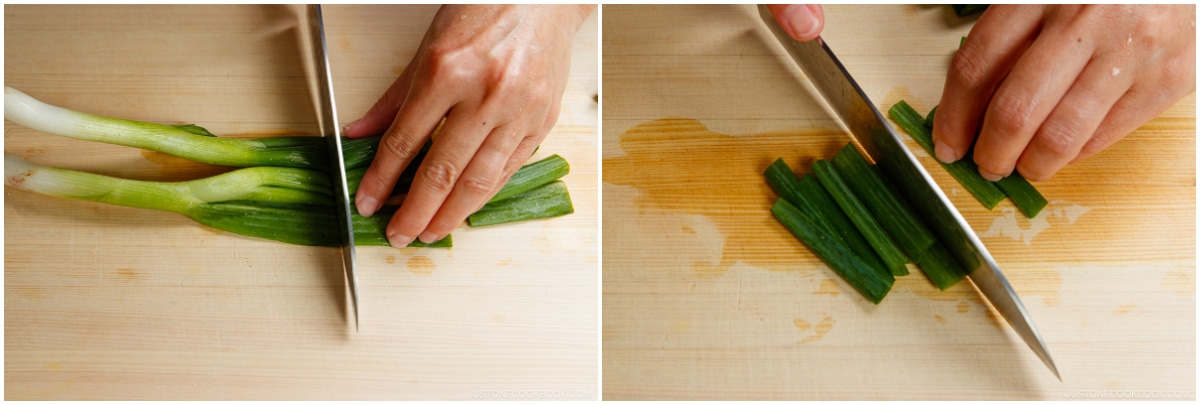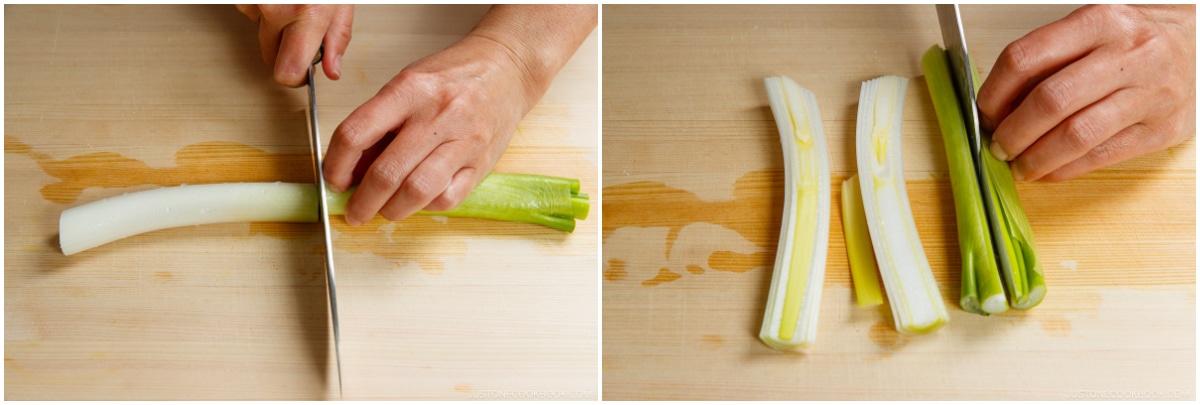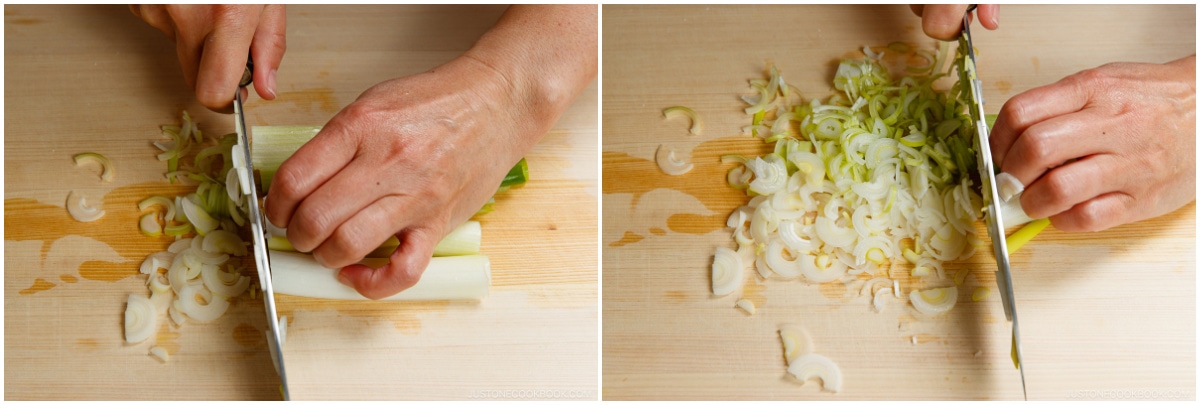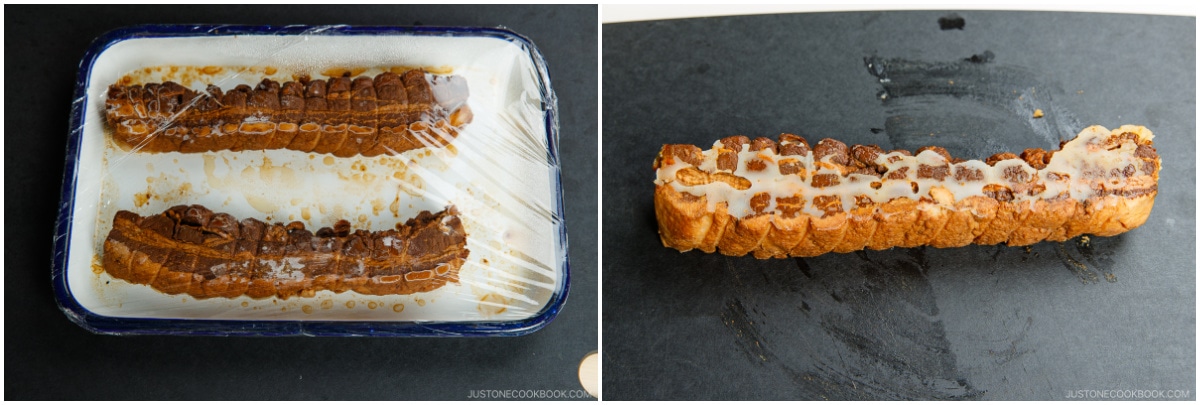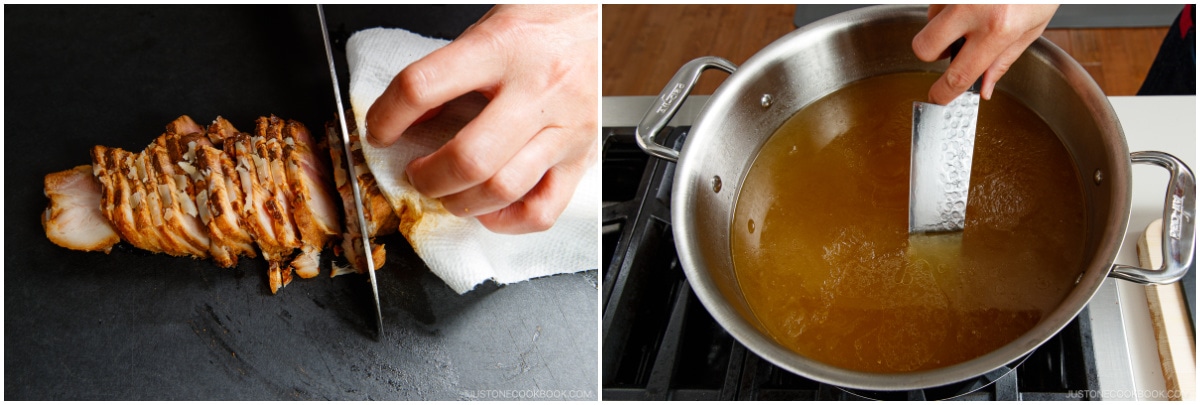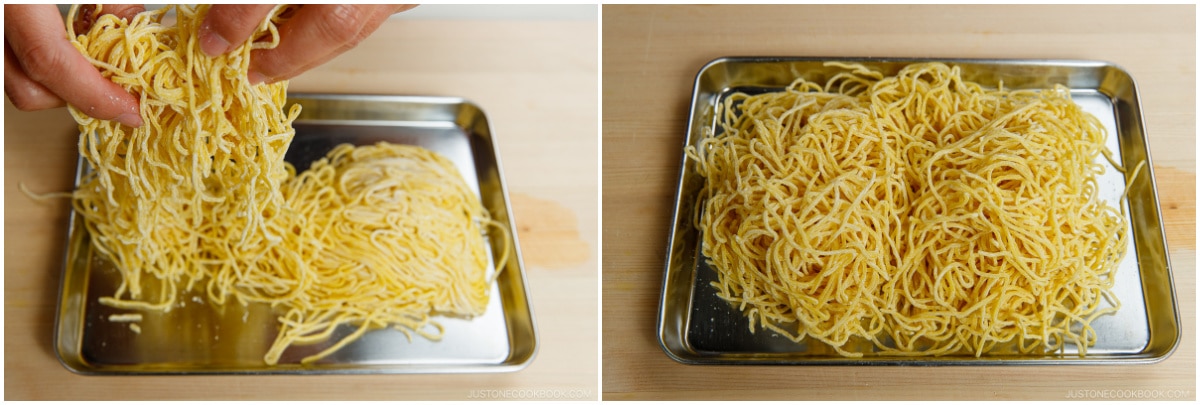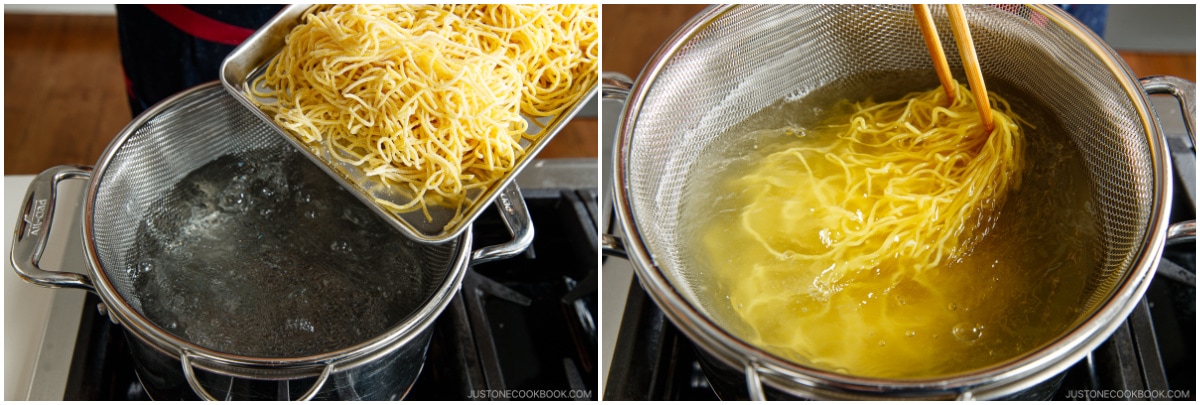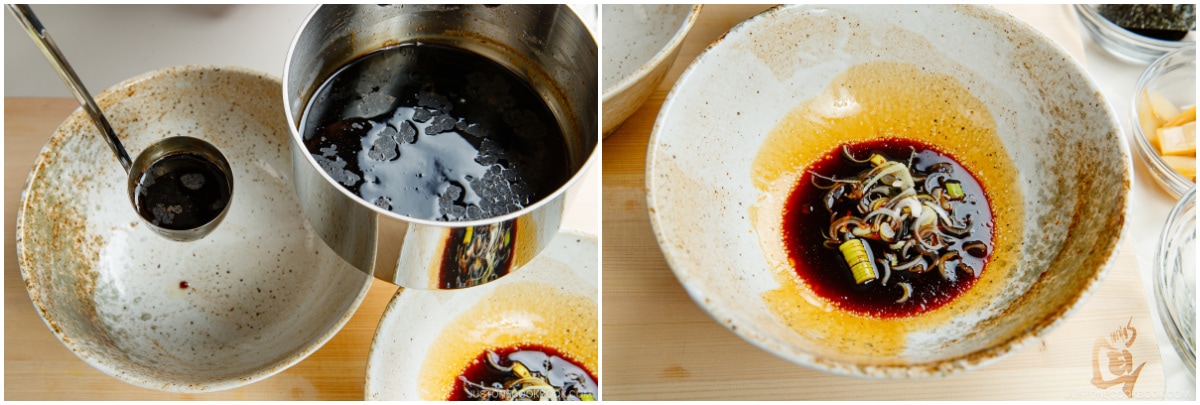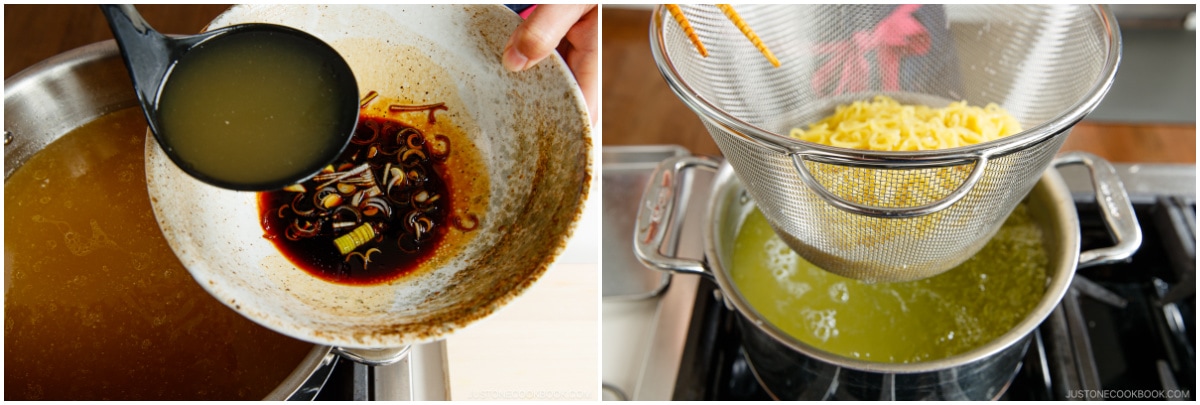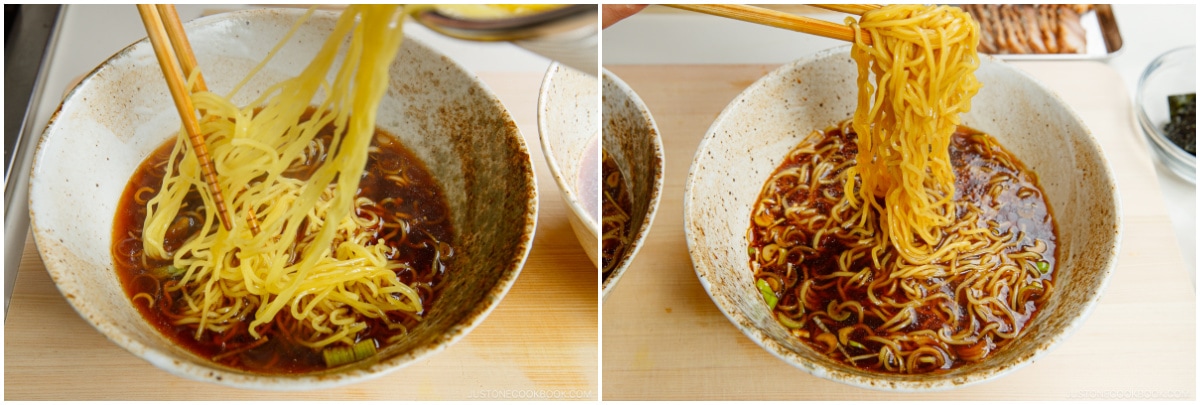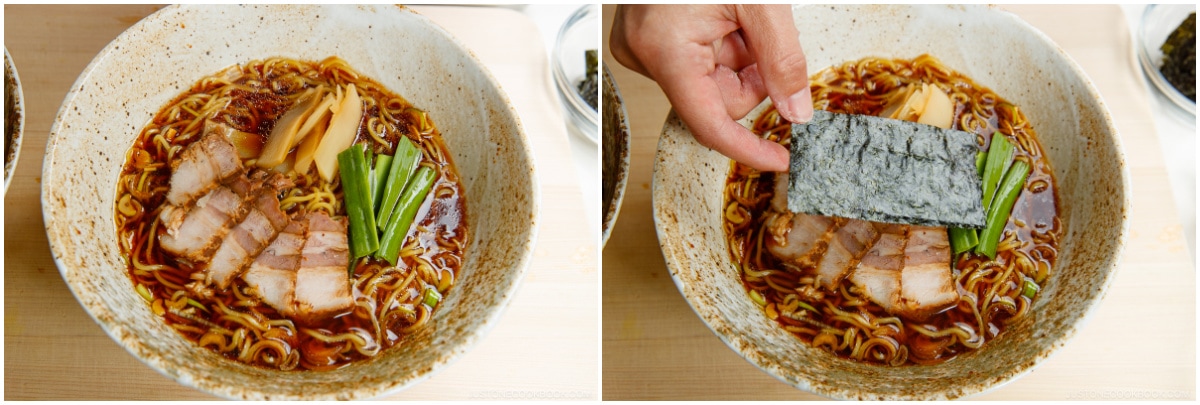Behold, my friends! This special bowl of shoyu (soy sauce) ramen is brought to you by Master Masamoto Ueda of Bizentei, a beloved neighborhood ramen shop in Tokyo. Made with a flavorful pork-bone broth with wavy noodles and topped with bamboo shoots, meltingly tender chashu pork belly, and thin-sliced green onions, it’s the most soulful bowl befitting a humble shop. I am beyond honored that I get to be the bearer of Master Ueda’s Shoyu Ramen recipe and to share his passion and generosity in feeding people. This is a labor of love, and I hope you enjoy every step of making this precious ramen at home! 日本語のレシピはこちら。
What is Shoyu Ramen?
Shoyu Ramen (醤油ラーメン), also known as Tokyo ramen, consists of a soy sauce flavor and a clear soup broth served with medium-thin curly noodles. The light but delicious soup stock is typically made from chicken bones and/or pork bones and occasionally kombu seaweed, dried anchovies, and katsuobushi (bonito flakes). Simple toppings of chashu Japanese pork belly, pickled bamboo shoots, green onions, and nori seaweed give Shoyu ramen its classic look. Shoyu ramen is considered an old-school classic in Japan. In 1910 (Meiji period), the first shoyu ramen was served at Rairaiken (来々軒) in Asakusa, Tokyo. At that time, it was called Tokyo Ramen. Rairaiken attracted 2,500 to 3,000 customers on the busiest day (the New Year holiday), which was unprecedented as 200 customers are considered a flourishing business nowadays. Among all the dishes sold at Rairaiken, shoyu ramen was its best seller and became the catalyst for the ramen’s popularity throughout Japan. Because the taste of soy sauce is familiar to Japanese people, shoyu ramen was easily and quickly accepted all over the country. If you’re interested to learn more about ramen, read this Japanese Ramen Guide.
Come Back Anytime – The Ramen Documentary Film
This Shoyu Ramen is a delicious result of the documentary film Come Back Anytime, directed by John Daschbach and produced by Wataru Yamamoto. Master Ueda and his wife Kazuko devoted almost 50 years of their lives serving up ramen to their loyal customers, which turned out to be an extension of a community. Although they have recently retired, we’re lucky that we get to experience and reflect on the couple’s endeavors in running the shop and more. To learn more about the film and watch it, please read this post.
Making Master Ueda’s Tokyo-Style Shoyu Ramen at Home
I am deeply grateful that we have the opportunity to collaborate with director John Daschbach, producer Wataru Yamamoto, and Master Ueda to put his recipe out to the world on Just One Cookbook. Master Ueda’s original shoyu recipe was 150 servings, so my task was to formulate his recipe into a family-friendly portion and decode the cooking steps in clear and concise instructions.
Why This Recipe Works for Everyone
Requires only 30 minutes of active cooking time. Like any complex soup broth, it requires simmering. For this broth, you’ll need 6 hours to be exact. However, the active cooking time is short. Don’t get intimidated by using pork bones! I’ve included the places to source the various ingredients. Once you gather everything, you’re off to a good start. Straightforward instructions to follow. It is not a technically challenging recipe, which means no fancy skills are required. With a little bit of patience, it’s 100% doable even for beginners. I have faith in you!
How to Make Shoyu Ramen
The Ingredients You’ll Need
Here is the list of ingredients we’ll need for making a classic bowl of shoyu ramen.
Substitutions
Pork bones – If you can’t find leg bones, use pork neck or spine bones. For the authentic flavor, it’s best to use the thigh bones (femur) and knuckles as I listed above. Pork belly strips – If you go to a local butcher or online butcher shop, you can definitely buy pork belly (and leg bones). If you really can’t get pork belly strips, then get a pork belly slab and cut it into strips. If you can’t get pork belly at all, then you can use pork shoulder (butt) and cut it into strips. Keep in mind that this is a different cut and the result will be different. However, Master Ueda thinks it’s an acceptable substitution. Rendered chicken fat – Please buy it online if you can’t find it locally. The flavor of the chicken fat in the soup broth is not something that we can easily substitute.
Required Cooking Equipment
12-QT stockpot – The stockpot is filled with water, bones, and aromatics first but will be reduced to just enough for 8 servings, after simmering down on high heat for 3 hours and on low heat for 3 hours. If you use a regular large pot, you will need to keep adding more water while simmering down; this will dilute the flavor of the soup broth and it’s not the right approach to making soup broth. Butcher twine – The pork belly has a lot of fat, which will render as it simmers in the soup broth. To keep the pork belly strips in good shape for making chashu, you will need to tie them with butcher twine. Fine-mesh skimmer – When cooking the bones, you will be skimming the scum and foam that appears on the soup broth surface. Having a good fine-mesh skimmer helps you achieve a nice and clean soup broth. Otoshibuta (drop lid) – This special Japanese drop lid minimizes evaporation, ensures the sauce is evenly distributed, and holds the food in place so it doesn’t fall apart during the simmering process. You can quickly make a DIY Otoshibuta with aluminum foil.
The Cooking Steps
Where to Get Fresh Ramen Noodles
Fresh ramen noodles are made from four ingredients: wheat flour, water, salt, and kansui. Despite the yellowish color, the noodles do not contain eggs. Kansui, an alkaline solution, is what gives ramen its yellow tint and springy texture.
Ramen noodles are either straight (ストレート麺) or wavy (ちぢれ麺). Generally, straight noodles are used for tonkotsu ramen while wavy noodles are used for soy sauce ramen, salt ramen, and miso ramen, but of course, there are exceptions. Ramen noodles have 6 different thicknesses: ultra-thin (極細麺), thin (細麺), medium-thin (中細麺), medium-thick (中太麺), thick (太麺), and extra thick (極太麺).
The ramen noodles used in shoyu ramen are usually the springy, wavy type. Big Japanese grocery stores like Mitsuwa, Nijiya, and Marukai (Tokyo Central) sell packages of fresh ramen noodles (with or without soup packages included). Some large Korean and Chinese grocery stores also carry packages of fresh ramen noodles from Myojo and Yamachan Ramen. Sun Noodles make great noodles and they ship domestically!
Shoyu Ramen Toppings
For this shoyu ramen, I followed exactly how Master Ueda makes his shoyu ramen. I added chopped white Tokyo negi into the shoyu tare and topped the ramen with the signature chashu, menma (seasoned bamboo shoots), green onion, and nori seaweed. At Bizentei, Ramen Egg (Ajitsuke Tamago) or soy-marinated egg was an add-on option.
8 Important Cooking Tips
Tip #1: Read the entire recipe at least twice.
Even though it’s a straightforward recipe, you will spend 6 hours simmering this ramen soup broth. You don’t want to discover later that you’ve missed an ingredient, equipment, or a cooking step. Therefore, read the entire recipe at least twice: once before going grocery shopping and again before making this recipe. Click “Print Recipe” to view the recipe without ads or to print the recipe.
Tip #2: Get a stockpot so you can simmer down the soup broth.
You’ll need a big stockpot so it can hold enough water for simmering the soup broth until it makes a flavor-concentrated soup broth. Please don’t use a regular (5-QT) large pot. Why? It doesn’t have enough space to hold the right amount of water, so you’d end up spending twice or three times as long to make a concentrated broth.
Tip #3: Tie the pork belly with butcher twine.
Make sure you wrap the pork belly as tightly as possible without squeezing or deforming it. The pork belly becomes super tender after simmering for 3 hours in the soup broth and 2 hours in the sauce. Butcher twine will keep it in good shape and prevent it from falling apart.
Tip #4: Skim all the scum and foam.
Clarity is the goal of this ramen soup broth. Take time to skim the scum and foam so that you get clear, clean-tasting soup broth. You don’t want impurities to be incorporated into the broth. I get obsessed with skimming and I go overboard.
Tip #5: Cook the soup broth, uncovered, on high and then low heat.
We need to evaporate the water to get concentrated soup broth. Cook the soup broth on high heat for 3 hours, and then turn it down to low heat and cook for another 3 hours.
Tip #6: Be gentle when removing the butcher twine.
With a pair of scissors, cut and remove the butcher twine from the chashu. Try not to handle the chashu too much because it is super tender and can easily fall apart. If some of the meat sticks to the twine, very gently remove it so you don‘t pull the meat off.
Tip #7: Chill the chashu.
Chill the chashu well until it’s cold and firm with the fat solidified so it stays together when you thinly slice it. Otherwise, the chashu will easily fall apart completely. Place it in the freezer for up to 1 hour until cold (but not frozen) if you‘re serving it right after the soup broth is made, in the refrigerator if you‘re serving it later the same day, or in the refrigerator overnight to serve the following day.
Tip #8: Adjust the flavor of the soup with tare and soup broth.
To each bowl, add 1-2 Tbsp of shoyu tare. The shoyu tare is extremely salty, so start with 1 Tbsp and see how you like it. Then, pour 1½ cups (360 ml) of the piping-hot soup broth into each bowl. Adjust the amount of tare and soup broth based on your ramen bowl size.
How can I make a vegan/vegetarian version?
Unfortunately, this recipe is based on pork bone broth. Please try and enjoy my Vegetarian Ramen recipe instead.
Do I really need to make 8 servings?
If you want to prepare fewer servings, I still recommend making the full portion of soup broth, chashu, and shoyu tare in this recipe. Then, you can freeze any leftovers to enjoy a quick bowl of delicious shoyu ramen within a month. I recommend freezing the broth in individual portions using these food prep containers so you can defrost the amount you need. The soup broth is very light so you will definitely crave it sooner than you think!
Do you need to season the soup broth with salt?
No, you don’t. The ramen’s salty flavor comes from the shoyu tare (sauce), and not from the soup broth. If you taste the tare, you’d notice it’s extremely salty. Adjust the amount of the shoyu tare for the measured soup broth for your ramen bowl.
Why is my chashu so salty?
Compared to my Chashu recipe, I also thought Master Ueda’s chashu was much saltier. I contacted the film director, John, to check on this and he confirmed that Master Ueda’s chashu is on the salty side. However, after I added the chashu slices to the ramen soup broth, it didn’t taste as salty since all the flavors blended in. The producer Yamamoto told me that sliced chashu was served as an appetizer at Bizentei and many customers ordered it to go with their alcoholic drinks.
What should I do with the leftover chashu?
You can definitely freeze the chashu for later use, make my Chashu Fried Rice with it, or use it as a topping on other noodle recipes.
Other Delicious Ramen Recipes
Miso Ramen Shio Ramen Spicy Shoyu Ramen Vegetarian Ramen Tan Tan Ramen (Tantanmen) Tsukemen (Dipping Ramen Noodles)
Readers’ Shoyu Ramen
Shoyu Ramen was the challenge recipe for JOC Cooking Challenge June/July 2023. Check out the delicious ramen created by JOC readers! Wish to learn more about Japanese cooking? Sign up for our free newsletter to receive cooking tips & recipe updates! And stay in touch with me on Facebook, Pinterest, YouTube, and Instagram.
